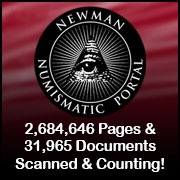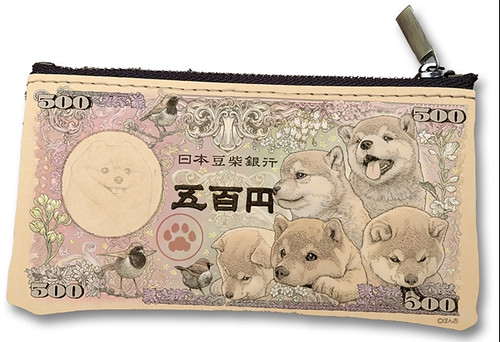
About UsThe Numismatic Bibliomania Society is a non-profit association devoted to the study and enjoyment of numismatic literature. For more information please see our web site at coinbooks.org SubscriptionsThose wishing to become new E-Sylum subscribers (or wishing to Unsubscribe) can go to the following web page link MembershipThere is a membership application available on the web site Membership Application To join, print the application and return it with your check to the address printed on the application. Print/Digital membership is $40 to addresses in the U.S., and $60 elsewhere. A digital-only membership is available for $25. For those without web access, write to: Charles Heck, Treasurer
AsylumFor Asylum mailing address changes and other membership questions, contact Chuck at this email address: treasurer@coinbooks.org SubmissionsTo submit items for publication in The E-Sylum, write to the Editor at this address: whomren@gmail.com BUY THE BOOK BEFORE THE COIN |
- WAYNE'S WORDS: THE E-SYLUM OCTOBER 13, 2019
- KOLBE LIBRARY SALE HIGHLIGHTS PART3
- NEW BOOK: BENT, HOLED, & FOLDED
- NEW BOOK: IN GOD WE TRUST
- NEW BOOK: LOST AND FOUND COIN HOARDS, 2ND ED.
- NEWMAN PORTAL ADDS THE CHECK COLLECTOR
- FUTURE OF NUMISMATICS: ROHAN
- VIDEOS: ART AND MEMORY: THE ROLE OF MEDALS
- PRINCETON NUMISMATIC DATABASE COORDINATOR
- MORE ON COIN REPLICAS MADE IN CHINA
- NOTES FROM E-SYLUM READERS: OCTOBER 13, 2019
- MORE ON THE SHERBROOKE SEMINARY SALE
- BANKNOTE CATALOG WEB SITE PROPOSED
- VOCABULARY TERM: FINGERPRINT TECHNOLOGY
- GEORGE WILLIAM ROBINETTE (1851-1916)
- ANA SERVICE AWARD NOMINATIONS SOUGHT
- REFORMING THE COMMEMORATIVE COIN PROCESS
- NUMISMAGRAM MEDAL SELECTIONS: OCTOBER 2019
- NUMISMATIC NUGGETS: OCTOBER 13, 2019
- A REINTERPRETATION OF THE 'JUDEA RECEPTA' LEGEND
- LINCOLN MEMORIAL CENT VARIETIES
- HACIENDA TOKEN OF TEQUILA MAKER GALLARDO
- RARE SILVER 1921 HARDING INAUGURAL MEDAL OFFERED
- ROYAL MINT OFFERS GOLD DEBIT CARD
- SACKLER OXY DOLLAR BLOOD MONEY NOTES
- ALTERNATIVE JAPANESE BANKNOTE SHIBA INA DESIGN
- GUINNESS RECORD: LARGEST BANKNOTE COLLECTION
- LOOSE CHANGE: OCTOBER 13, 2019
- ROMAN BUTIN'S BEATING HEART COIN
- FEATURED WEB PAGE: LIBERTY TRADING COMPANY
Click here to access the complete archive
Click here to unsubscribe (scroll down)
To comment or submit articles, reply to whomren@gmail.com
Content presented in The E-Sylum is not necessarily researched or independently fact-checked, and views expressed do not necessarily represent those of the Numismatic Bibliomania Society.
WAYNE'S WORDS: THE E-SYLUM OCTOBER 13, 2019
 New subscribers this week include: Richard Kelleher, and Susan Helene Sims. Welcome aboard! We now have 6,002 subscribers.
New subscribers this week include: Richard Kelleher, and Susan Helene Sims. Welcome aboard! We now have 6,002 subscribers.
Thank you for reading The E-Sylum. If you enjoy it, please send me the email addresses of friends you think may enjoy it as well and I'll send them a subscription (but let me know if they are located in the European Union). Contact me at whomren@gmail.com anytime regarding your subscription, or questions, comments or suggestions about our content.
This week we open with more highlights of the George F. Kolbe library sale, three excellent new books, updates from the Newman Numismatic Portal and Princeton University, and some scary coin reproductions from China.
Other topics this week include ANA Service Award nominations, proposed reforms for the U.S. commemorative coin process, medals, the 'Judea Recepta' coin legend, Lincoln Memorial Cent varieties, the 1794 Starred Reverse Cent, and the Edsel B. Ford medal.
To learn more about Fractional Currency Shields, tequila tokens, bent, holed & holed coins, witch bottles, the motto "In God We Trust", The Check Collector, blood money notes, the Royal Mint's gold debit card and Roman Butin's beating heart coin, read on. Have a great week, everyone!
Wayne Homren
Editor, The E-Sylum
KOLBE LIBRARY SALE HIGHLIGHTS PART3
This press release provides additional highlights from the upcoming Kolbe & Fanning sale of the George F. Kolbe library. -Editor
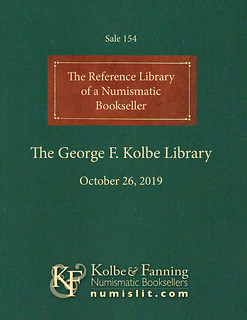 We are less than two weeks away from the October 26 auction of the George F. Kolbe Library, being offered by Kolbe & Fanning Numismatic Booksellers. Printed
catalogues have been mailed and the auction can be accessed via our online auction platform at bid.numislit.com. A PDF of the printed
catalogue can also be downloaded from the main Kolbe & Fanning website at numislit.com. The Kolbe Library includes those works
catalogued by George in his 2012 book, The Reference Library of a Numismatic Bookseller, as well as additional items acquired in the years since. The October 26 auction
comprises an outstanding offering of numismatic bibliographies, reference books, catalogues, and special editions from around the world, amassed over a career spanning more than
fifty years.
We are less than two weeks away from the October 26 auction of the George F. Kolbe Library, being offered by Kolbe & Fanning Numismatic Booksellers. Printed
catalogues have been mailed and the auction can be accessed via our online auction platform at bid.numislit.com. A PDF of the printed
catalogue can also be downloaded from the main Kolbe & Fanning website at numislit.com. The Kolbe Library includes those works
catalogued by George in his 2012 book, The Reference Library of a Numismatic Bookseller, as well as additional items acquired in the years since. The October 26 auction
comprises an outstanding offering of numismatic bibliographies, reference books, catalogues, and special editions from around the world, amassed over a career spanning more than
fifty years.
A few selected highlights include:
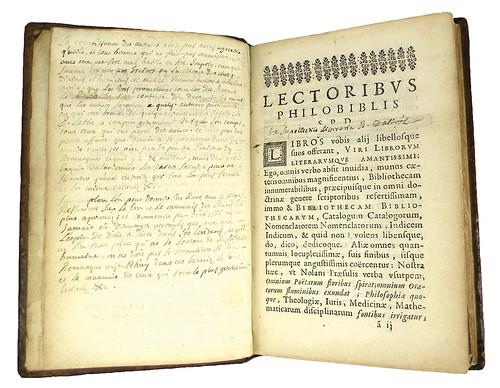
Lot 2
Lot 2: the first edition of Philippe Labbé's enormously important 1664 Bibliotheca bibliothecarum, which includes the first substantial (nearly 100 pages) numismatic bibliography
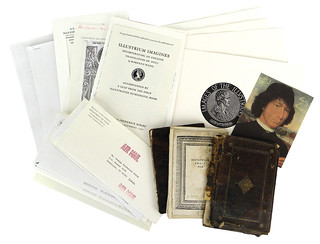
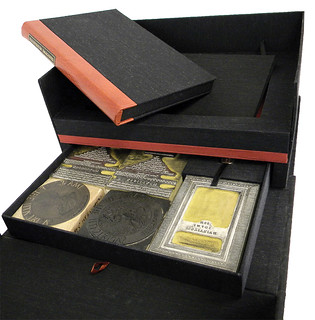
Lot 43
Lot 43: a unique archive of materials relating to the 2001 leaf book printed by Henry Morris and published by George Kolbe of Andrea Fulvio's 1517 Illustrium imagines, the first illustrated numismatic book

Lot 67
Lot 67: George Kolbe's complete set of the catalogue of the American Numismatic Society Library, augmented by hundreds of inserts

Lot 178
Lot 178: a complete set of l'Année philologique, 1896–2003, a rarely utilized resource for reviews of numismatic publications printed in non-numismatic publications


Lots 243 and 421
Lot 243: the rare memorial volume published in honor of Ernst Justus Haeberlin, in a deluxe binding
Lot 421: George Kolbe's guest book, printed by Henry Morris and bound by Bernard Middleton, recording the visits over the years of many numismatic bibliophiles to the Kolbe residence
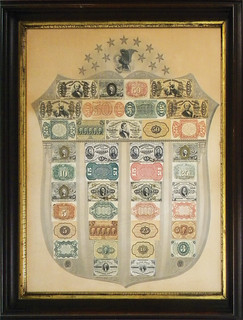
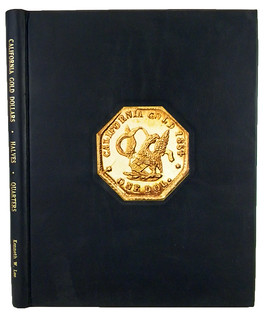
Lots 451 and 461
Lot 451: a remarkably well-preserved Fractional Currency Shield
Lot 461: the publisher's copy of the Super-Deluxe Edition of Kenneth Lee's California Gold Dollars, Half Dollars, Quarter Dollars..., bound in full leather with extra photographic illustrations
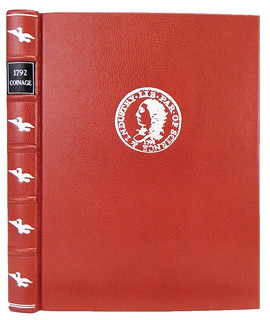
Lot 472
Lot 472: one of five copies produced of the Authors' Edition of 1792: Birth of a Nation's Coinage, by Pete Smith, Joel Orosz, and Len Augsburger
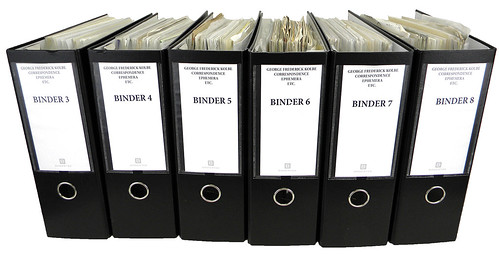
Lot 525
Lot 525: George Kolbe's archives, including decades of correspondence, ephemera, photographs, and miscellaneous items, held in eleven large binders and four archival storage boxes.
Kolbe & Fanning use Auction Mobility as our third-party online bidding platform. To register for the sale, bidders should go to bid.numislit.com and sign up. Once you have set up an account, you may browse lots, place advance bids, or participate in the live sale on your computer, tablet, or phone. Please note that as this is a third-party site, your login information for the main K&F site will not work for the auction site: you need to establish a separate account. Those wishing to participate on their devices can download the Kolbe & Fanning app through the Apple or Google Play Store.
Bids also may be placed via post, email, fax or phone. Bids placed via post, email, fax or phone must be received by October 25, the day before the sale, in order for them to be processed. Advance absentee bids may also be placed at any time online at bid.numislit.com; live internet bidding will be available during the sale itself through the same platform.
Kolbe & Fanning Numismatic Booksellers LLC is a licensed and bonded auction firm in the State of Ohio. For more information, please see the Kolbe & Fanning website at numislit.com or email David Fanning at df@numislit.com. To register for the sale, go to bid.numislit.com. To sign up to receive Kolbe & Fanning's occasional email announcements, please visit numislit.com or email Maria Fanning at maria@numislit.com. We look forward to your participation.
To read the earlier E-Sylum articles, see:
KOLBE & FANNING SALE 154 ANNOUNCED (https://www.coinbooks.org/v22/esylum_v22n39a02.html)
KOLBE LIBRARY SALE HIGHLIGHTS PART2 (https://www.coinbooks.org/v22/esylum_v22n40a03.html)

NEW BOOK: BENT, HOLED, & FOLDED
Michael Shutty's new book, Bent, Holed & Folded was this year's winner of the Numismatic Literary Guild's prize for Best Specialized Book: Numismatic History or Personalities. He sent this official announcement for E-Sylum readers. Thanks! -Editor
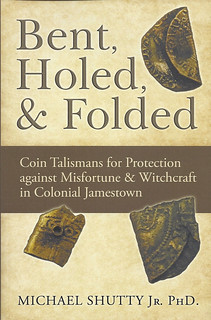 NEW BOOK. BENT, HOLED, & FOLDED: Coin Talismans for Protection against Misfortune & Witchcraft in Colonial Jamestown, by Michael Shutty, Jr. Published by
Wasteland Press. ISBN: 978-1-68111-297-8.
NEW BOOK. BENT, HOLED, & FOLDED: Coin Talismans for Protection against Misfortune & Witchcraft in Colonial Jamestown, by Michael Shutty, Jr. Published by
Wasteland Press. ISBN: 978-1-68111-297-8.
Like many collectors interested in the coins used in Colonial America, I was intrigued by the discoveries in Jamestown, Virginia, made by William Kelso and his team of archaeologists. I dove headlong into the field reports filled with maps, diagrams, and artifacts. I read each report in succession as if it were a Dickens serial. Here, I experienced history unfolding in real time – a delectable oxymoron that does not happen often.
All sorts of coins were found in the dirt within the bounds of the palisaded fort, many of them undisturbed since the first quarter of the seventeenth century. The mix included over seventy English silver and copper pieces, over a hundred Irish pennies, and countless jettons; also there was a potpourri of tokens and foreign coins. What I didn't realize was that some of these coins were fashioned into magical talismans for protection against misfortune and witchcraft.
I stumbled onto this subject after reading about several mutilated coins excavated at Jamestown. The coins appeared to have been damaged on purpose. I was intrigued. And so, I set out to find out how these coins – bent, holed, and folded – were used. This book recounts my quest to understand how the colonists employed these objects to stay safe and prosperous. But I give you fair warning: magic is not easy, as facts and folklore blend together like butter and margarine. You must tolerate ambiguity while embracing the incredulous.
For several years, I worked closely with Jamestown Rediscovery Curator, Merry Outlaw, to view these mutilated coins and compare them with similar coins found all across England. Together we explored magical traditions that stretched back to medieval times when English coins were routinely bent, holed, and folded and offered to the saints for protection. These traditions continued in various forms throughout the seventeenth century and were brought to Virginia by the colonists.
Along the way, I encountered battered coins that appeared no more magical than a rusty nail. But looks can be deceiving. I also learned more about divine providence, dead saints, and witches than I anticipated. But mostly, I was impressed with the ingenuity of common folks who conjured up occult forces when needed. I must confess that like many collectors and historians interested in Colonial America, I overlooked the impact of supernatural beliefs on their actions. Yet, we can all acknowledge that spiritual ideas (or lack thereof) shape what we say and do even now – so it was in colonial times.
This is fresh ground, and I think numismatists and historians interested in the American colonial period will enjoy this book and learn from it. It was not until Ralph Merrifield popularized the topic in his 1987 book, The Archaeology of Magic and Ritual, that archaeologists became attuned to relics with magical significance. Consider horseshoes for example. Before Merrifield, most of them were interpreted as barnyard litter. Now we recognize that some horseshoes protected the farm, as if to say: No witches allowed! The same can be said for some bent coins.
If you have ever wondered about bent, holed, and folded coins, this book reviews the finds at Jamestown and at other colonial sites upriver near Henrico and across the Chesapeake Bay near St. Mary's City. I also consider a few bent shillings from Massachusetts. In addition, I examine hundreds of finds described in the Portable Antiquities Scheme in England (a database of ground finds run by the British Museum). And if you ever wondered about the use of witch bottles, religious medals, horseshoes, or old shoes hidden in the attic, then this book is for you.
Suffice to say that fear is a potent call to action. As a clinical psychologist I know this well. It is an unbearable emotional state that drives folks to defend themselves any way they can. Fear underlies all of the talismans described in this book. Coin talismans represent proactive coping strategies. In each case, the way a talisman was employed was limited only by the creativity and ingenuity of the user. After all, the power of magic was available to anyone familiar with the old ways.
This soft-cover book has 150+ pages, with over 100 references, and detailed endnotes for each chapter. Collectors, numismatists, and archaeologists will not be disappointed. The book has two Forewords: one written by Jamestown Rediscovery Curator, Merry Outlaw, and one written by Numismatist, Author, and my friend, Will Nipper. There are many photographs and descriptions of coin talismans that are not on display at Jamestown and other sites in Maryland. My intent was to write a lively and entertaining book, so I encourage you to give it a read. The book is available for $19.95 from Internet booksellers or from author (signed & postage paid) at mykshutty@yahoo.com. Just send me an email if interested. This book won the 2019 Best Specialized Book of Numismatic History or Personalities from the Numismatic Literary Guild.
What a great topic for a book-length treatment! There has been endless discussion and speculation over damaged coins of the U.S. colonial era, especially the so-called "Witch Pieces". I'll look forward to reading the book and learning what Shutty discovered on this subject. -Editor
To read the earlier E-Sylum article, see:
2019 NUMISMATIC LITERARY GUILD AWARD WINNERS (https://www.coinbooks.org/v22/esylum_v22n34a09.html)
NEW BOOK: IN GOD WE TRUST
Here's the press release from Whitman Publishing on Bill Bierly's upcoming book on the "In God We Trust" motto. -Editor
and Its Effects on American Money, Banking, and Religion
 Whitman Publishing announces the release of In God We Trust: The American Civil War, Money, Banking, and Religion, by numismatic researcher William Bierly. The
352-page hardcover book will debut in November 2019. It will be available from booksellers and hobby shops nationwide, and online (including at www.Whitman.com), for $29.95.
Whitman Publishing announces the release of In God We Trust: The American Civil War, Money, Banking, and Religion, by numismatic researcher William Bierly. The
352-page hardcover book will debut in November 2019. It will be available from booksellers and hobby shops nationwide, and online (including at www.Whitman.com), for $29.95.
The national motto "In God We Trust" debuted on United States coinage during the chaos and heartache of the American Civil War. It has appeared on our money ever since. Bierly, digging deep into the origins and history of "In God We Trust," tells its full story for the first time, introducing Reverend Mark Watkinson, the preacher who inspired the Treasury Department to "recognize Almighty God in some form on our coins" . . . Mint Director James Pollock, former governor of Pennsylvania, "a commanding figure" who worked toward the same vision . . . and Treasury Secretary Salmon P. Chase, nephew of an Episcopal bishop, who marshalled the nation's vast resources and financed the war with bold innovations. President Abraham Lincoln figures in the tale, as does a cast of military generals, wealthy industrialists, poets and artists, powerful bankers, and everyday Americans, North and South.
Bierly shows how the upheaval of the Civil War changed not just the face of our coins and paper currency, but the very foundations of modern American banking and finance.

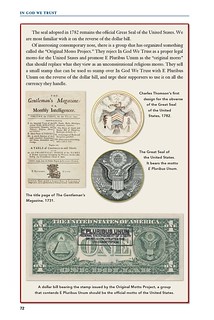
The story continues into the renaissance of beautiful American coinage started by President Theodore Roosevelt in the early 1900s . . . the religious revival of the 1950s, and the "Unwritten Constitution" . . . legal challenges by modern-day atheists . . . and controversy surrounding "In God We Trust," public and school prayer, Ceremonial Deism, the separation of Church and State, and other topics very relevant in today's social and political conversations.
Historian Q. David Bowers, former president of the American Numismatic Association, calls In God We Trust "One of the most detailed, intricate, and fascinating books in the field of American numismatics—and in American history in general." On the author's style, Bowers says, "Bierly approaches the subject respectfully on all sides, with color, personality, dashes of humor, and dogged pursuit of the truth."
In God We Trust is available for preorder now.
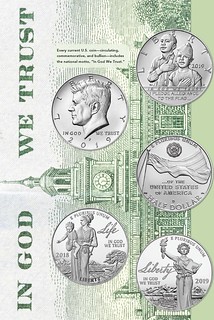

In God We Trust: The American Civil War, Money, Banking, and Religion
By William Bierly; foreword by Q. David Bowers
ISBN 0794845282
Hardcover, 6 x 9 inches, 352 pages, full color
Retail $29.95 U.S.
About the Author
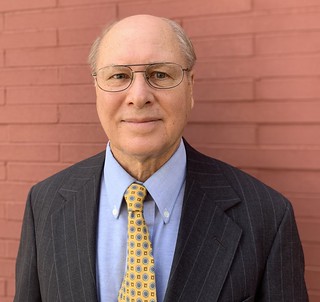 William (Bill) Bierly was raised on a farm near Walkerton, Indiana. As a child he heard stories from his grandparents about two of his great-grandfathers who had served
in the Civil War. This led to a lifelong interest in that war and that period of history. At about age eight he began collecting coins from circulating change. Following high
school Bierly attended Northwestern University for two years and then completed a degree in sociology and economic development with a minor in Chinese studies at Indiana
University. He then worked in India for two years as a Peace Corps volunteer in a dairy development project.
William (Bill) Bierly was raised on a farm near Walkerton, Indiana. As a child he heard stories from his grandparents about two of his great-grandfathers who had served
in the Civil War. This led to a lifelong interest in that war and that period of history. At about age eight he began collecting coins from circulating change. Following high
school Bierly attended Northwestern University for two years and then completed a degree in sociology and economic development with a minor in Chinese studies at Indiana
University. He then worked in India for two years as a Peace Corps volunteer in a dairy development project.
Back in the United States his interest in coins was rekindled. He soon went abroad again, working for three years in Osaka, Japan. Then in the United States he operated a small business for five years, sold it, and entered graduate school, earning an MBA in finance from Indiana University and embarking on a 25-year career in commercial banking. With his overseas experience Bierly focused on international banking, particularly Japanese corporate business and Asian correspondent banking. He began his career at National Bank of Detroit and he worked with J.P. Morgan Chase for much of his career; at various times at the bank's Detroit, Chicago, and Columbus, Ohio, offices, as well as traveling often to Asia.
While thus engaged, Bierly continued to pursue his coin hobby, eventually specializing in Civil War–era coinage, in particular pattern coins. Today he is active in several coin groups and clubs, most notably the Central States Numismatic Society, the American Numismatic Association, the American Numismatic Society, the Chicago Coin Club, the Michigan State Numismatic Society, and the Pennsylvania Association of Numismatists, as well as the Civil War Token Society and the Liberty Seated Collectors Club. He sometimes exhibits his collection at major coin shows and frequently volunteers as an exhibit judge.
Bierly resides in LaPorte, Indiana. He has two children, Emma and Ken, as well as a granddaughter, Kiki.
I was pleased to get a sneak peek into Bill's manuscript when I ran into him and Dennis meeting at the American Numismatic Association World's Fair of Money in Chicago this summer. This is a long-awaited book on an important subject in American numismatics. I expect it will sell briskly, so order your copy soon from your favorite numismatic bookseller. -Editor
Dennis Tucker adds:
We've had more interest in In God We Trust than in any numismatic book in several years. It's one of those subjects that has crossover appeal into "mainstream" history and social/political/economic/financial fields. I'm excited for it to hit the bookshelves!
For more information, or to preorder, see:
In God We Trust
(https://www.whitman.com/store/Inventory/Detail/In-God-We-Trust+0794845282)
THE BOOK BAZARRE
NEW BOOK: LOST AND FOUND COIN HOARDS, 2ND ED.
Whitman has published a new, updated edition of Dave Bowers' book on coin hoards. Here's an article submitted by Whitman's Dennis Tucker. -Editor
Q. David Bowers's Lost and Found Coin Hoards and Treasures, one of the most exciting coin-collecting books of recent years, has been released in a new second edition by Whitman Publishing. The 480-page hardcover book is available online and in bookstores and hobby shops nationwide. Here, Whitman publisher Dennis Tucker recalls how the book came to be.
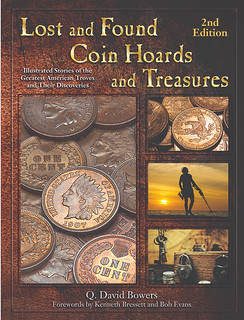 In the summer of 2014 at Whitman Publishing we started planning a new book by Q. David Bowers. I remember talking with our editorial team about the project. Its
foundation would be several decades' worth of Bowers's research on American coin treasures and hoards. His information-gathering had started in the 1950s when he was a young man
just beginning what would become a lifelong career as a numismatist and historian. Over the years and decades Dave would write about coin hoards and treasures in numerous columns,
articles, auction catalogs, books, and elsewhere. His first book devoted entirely to the subject was published in 1997. These 50-plus years of research would form the basis of a
new, bigger, updated volume that we planned to publish in 2015.
In the summer of 2014 at Whitman Publishing we started planning a new book by Q. David Bowers. I remember talking with our editorial team about the project. Its
foundation would be several decades' worth of Bowers's research on American coin treasures and hoards. His information-gathering had started in the 1950s when he was a young man
just beginning what would become a lifelong career as a numismatist and historian. Over the years and decades Dave would write about coin hoards and treasures in numerous columns,
articles, auction catalogs, books, and elsewhere. His first book devoted entirely to the subject was published in 1997. These 50-plus years of research would form the basis of a
new, bigger, updated volume that we planned to publish in 2015.
Lost and Found Coin Hoards and Treasures included some two dozen significant updates to earlier published essays, with new research and sales information, plus recent discoveries from the past ten to fifteen years and, notably, a dramatic update to the story of the sunken SS Central America. The latter was and is one of Dave's greatest numismatic obsessions. For many years, since I became publisher at Whitman in 2004, I'd heard him extol the genius and hard work required to find the amazing shipwreck and bring its gold and silver to the surface. "No larger Gold Rush–era treasure was ever lost," he would say, "so by definition no greater American treasure can ever be found!" I was delighted that he would be able to update the story with exciting news of the ship's latest (2014) exploration and additional recoveries from the wreck site.
In his manuscript, Dave shared his ongoing research and added many modern-day discoveries, showing that treasure isn't just in children's tales and pirate stories. The SS North Carolina, lost in July 1840 off the coast of South Carolina with a treasure of silver and gold coins, was found in the year 2000. The SS Republic, shipwrecked in a hurricane in October 1865 off the Georgia coast, was found in 2003 with its load of silver and gold coins. The side-wheel steamship SS New York, swamped in 1846 in a "perfect gale" off the coast of Texas, was located in 2005. Back on dry land, Dave shared Ron Gillio's personal recollection of the Wells Fargo Hoard of nearly 20,000 (!) 1908 No Motto double eagles. In 2013 the Saddle Ridge Hoard of gold coins was discovered—almost $28,000 in face value alone—buried in eight metal cans in California around 1894, and appraised at $10 million. In 2015 the Stack's West 57th Street Hoard came to light: more than a million coins, weighing some 60,000 pounds and including sacks of tens of thousands of large cents, bag quantities of Barber silver coins, ten thousand 1909 V.D.B cents, and many others. That same year the Massachusetts State House time capsule was exhumed, after being hidden in 1795 with a cache of coins and opened and resealed in 1855 with the addition of more coins.
After describing hundreds of discovered hoards and treasures, and illustrating that such finds are still happening today, Dave offered two more tantalizing chapters, "Undiscovered Treasures on Land" and "Unrecovered Sunken Treasures." Hundreds of tidbits, clues, and rumors, laid out state by state, offer more possibilities to set a treasure-hunter's heart and mind racing.
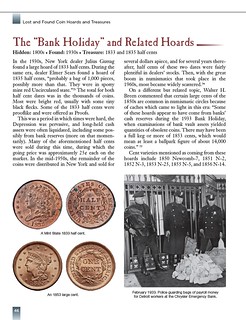
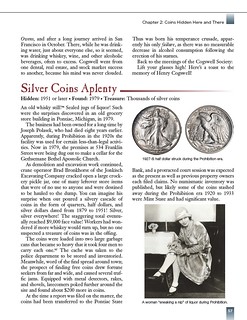
Creating a Book About Coins and People
By the time we started work on Lost and Found Coin Hoards and Treasures in 2014, I had overseen the publication of nearly 30 books by Dave Bowers. That averaged to about three books per year, not counting his editorship of the Guide Book of United States Coins, putting him firmly in the ranks of the most prolific American historians. Many of these books were updated in multiple editions over the years—a good measure of their popularity.
Dave's process for building the Lost and Found manuscript was in classic Bowers style: drawing on a lifetime of carefully gathered and organized research; seeking insight and information from experts and specialists; striving always for numismatic accuracy and detail; and telling good stories and telling them well. Add to that approach a near-photographic memory and the wits and knowledge to make a hundred mental connections where most people would make one or two. And fold in Dave's ability to see American and world history in both a big-picture view and in homey, local, very personal context. This was the recipe that created his wonderfully unique exploration of a fascinating subject.
Lost and Found Coin Hoards and Treasures is a book about coins, but on a deeper level it's a book about people. Some of the personalities Dave introduced were quirky, like coin hoarder Alexander Miller, who lived in a tiny town in Vermont, rarely spoke with the outside world, and also collected airplane parts and vintage cars. Some were courageous, like Captain William Lewis Herndon, who went down with the hurricane-stricken Central America after evacuating the ship's women and children.
Perhaps most appealingly, Lost and Found is about the people who find the hidden hoards and treasures, whether they're farmers digging in the earth, adventurous boys exploring a basement, metal-detectorists sweeping a potato field, or scientists calculating the precise location of a sunken shipwreck. The gold and silver are out there waiting to be found, by accident or by design. The finders could be any of us, if we're lucky or smart, or both. That's the excitement that Dave taps into and fuels with his storytelling.
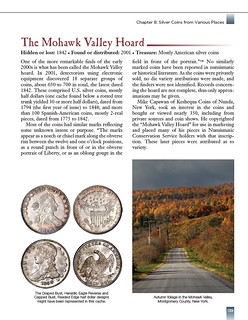
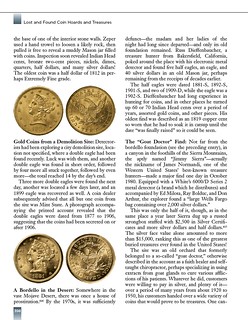
"A Treasure Trove of Colorful and Fun Facts"
The "Sage of Wolfeboro" wrapped up nearly all his text manuscript and gathered its accompanying images by the end of 2014. All that remained to be finished was the updated section on the SS Central America, which was still being reviewed and fine-tuned by various experts. (As I told our editorial staff at the time, "The Central America is an active shipwreck site, so there are teams of people involved," and it took time to ensure the story was told correctly.) Bob Evans, chief scientist and historian of the recovery of the Central America, wrote a foreword for the new book, as did Kenneth Bressett, longtime editor of the Guide Book of United States Coins.
More than 600 photographs, engravings, drawings, maps, coin images, and other illustrations made the new book visually as colorful as its narrative. (A review in the journal of the American Numismatic Society would describe the images as "eye candy.")
The book debuted in October 2015 and was an immediate success. Numismatist Mike Thorne, in Coins Magazine, May 2016, "merely scratched the surface" (his words) in his full-page review of the book, calling it "a magnificent effort" and stating that "this volume belongs in the library of any coin collector who likes to dream about finding a great hoard." California Bookwatch's "Antiques/Collectibles Shelf" called it "a treasure trove of colorful and fun facts . . . accessible to coin collectors and adventure readers alike." Midwest Book Review, which makes recommendations to libraries and others, called it "an absolutely fascinating and profusely illustrated read from beginning to end," "impressively well researched, written, organized, and presented," and "very highly recommended for personal, community, and academic library collections."
By 2018, after a good print run, the first edition was sold out of our inventory and we started to plan a second edition—the book now available—for publication in 2019.
The latest edition has more than 50 new photographs, and numerous updates to its essays. Ongoing research and consultation with specialists have led to some significant revisions and additions. From Forgotten Colorado Silver: Joseph Lesher's Defiant Coins (2017) came Robert D. Leonard Jr.'s and Kenneth Hallenbeck's discussion of a rumored hoard of Lesher Referendum Dollars. John M. Kleeberg recommended the removal of Missouri's Wilson Tilley treasure from the chapter on "Hoaxes, Fantasies, and Questioned Finds," pointing to evidence of its very real existence. Other essays were updated with recent findings. In the meantime, research is ongoing, and newly discovered hoards and treasures—such as that of the steam-packet Pulaski, lost in a maritime disaster in 1838 and brought to light in 2018 and 2019—will undoubtedly be added to future editions.
After all, the coins are out there. They just need to be found and reported . . . and then they make history.
Lost and Found Coin Hoards and Treasures, 2nd edition
By Q. David Bowers; forewords by Kenneth Bressett and Bob Evans
ISBN 0794846440
Hardcover, 8.5 x 11 inches
480 pages
Full color
Retail $39.95 U.S.
I enjoy Dennis' articles on "The Writing of ..." Whitman's various classic numismatic books. It's nice to have additional color beyond the standard press release. -Editor
For more infomration, or to order, see:
Lost and Found Coin Hoards and Treasures 2nd Edition
(https://www.whitman.com/store/Inventory/Detail/Lost-and-Found-Coin-Hoards-and-Treasures-2nd-Edition+0794846440)
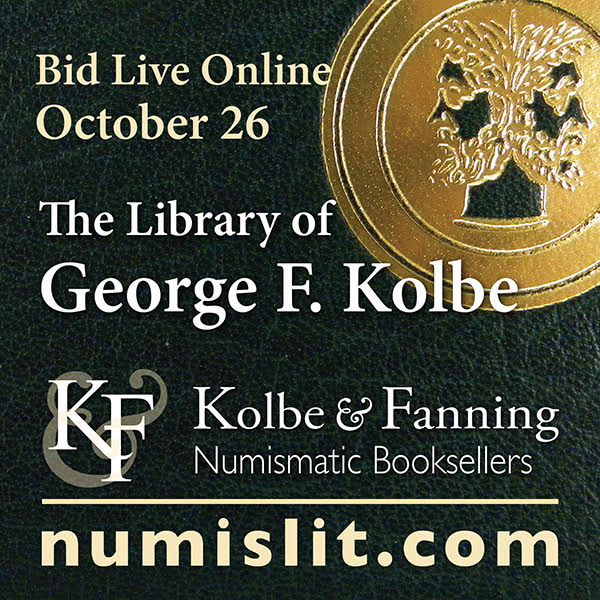
NEWMAN PORTAL ADDS THE CHECK COLLECTOR
The latest addition to the Newman Numismatic Portal is The Check Collector. Project Coordinator Len Augsburger provided the following report. -Editor
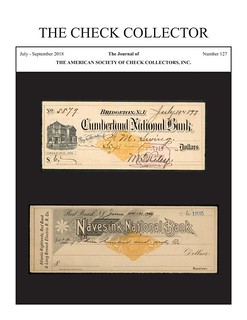 Newman Portal Adds The Check Collector
Newman Portal Adds The Check Collector
With the gracious permission of the American Society of Check Collectors, The Check Collector has recently been added to Newman Portal. Vintage checks are a launching pad for the study of banking histories, financial printing, and related commercial matters. Newman Portal acknowledges Bob Hohertz for his assistance with this journal, which sadly ceased publication in December, 2018. Fortunately, back issues are now archived on Newman Portal, preserving this slice of numismatic collecting history for future generations.
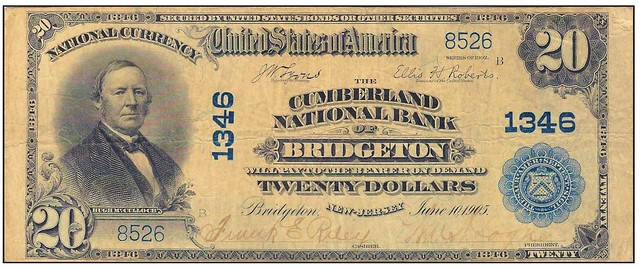
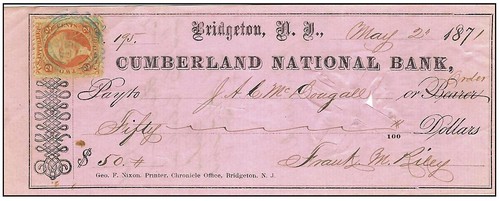
Images: National Bank note of the Cumberland National Bank (Bridgeton, NJ), along with an 1871 check drawn on the same bank, from an article by Todd R. Sciore in the July-September 2018 issue of The Check Collector.
Link to The Check Collector on Newman Portal:
https://nnp.wustl.edu/library/publisherdetail/533715
FUTURE OF NUMISMATICS: ROHAN
These are selections from the David Lisot Video Library that feature news and personalities from the world of coin collecting. David has been attending coin conventions since
1972 and began videotaping in 1985. The Newman Numismatic Portal now lists all David's videos on their website at:
https://nnp.wustl.edu/library/multimediadetail/522852
Here's one from the ANA Future of Numismatics Symposium. -Editor
 Future of Numismatics Symposium: Greg Rohan
Future of Numismatics Symposium: Greg Rohan
An excerpt of the video is available for viewing on the Coin Television YouTube Channel at:
https://youtu.be/RULGEWcSjZA
This video is a highlight from Future of Numismatics Symposium: What the Future May Hold
Donn Pearlman, Moderator, David Lisot, Video Producer, CoinTelevision.com.
At the 2019 World's Fair of Money the American Numismatic Association asked some of the coin industry's most influential leaders about what they believe is in store for the future of the hobby. Hear these titans of numismatics share what they believe the future holds.

VIDEOS: ART AND MEMORY: THE ROLE OF MEDALS
Videos documenting presentations at last year's conference Art and Memory: The Role of Medals have been published. For those of us unable to attend in person, this is a great opportunity to catch up on the field from the top experts in the country. What a great event! -Editor

Last November, the Medal Collectors of America and the Massachusetts Historical Society teamed up to organize an unprecedented conference on medals and medal collecting, Art and Memory: The Role of Medals. The objective was to provide a venue for scholarly presentations and discussion around a range of topics related to collecting and enjoying medals, with plenty of time around the edges for social enjoyment.
While the social opportunity has come and gone, high definition video of all of the presentations and panel discussions are now available via the following links:
MHS Numismatic Collection
Anne Bentley, MHS Curator of Art & Artifacts, documents the Society's numismatic collection beginning in 1791 with the donation of a copper Columbia and Washington medal
from the Boston merchants who financed the venture and touches on highlights of the MHS collection.
Their Secrets Revealed!
John Sallay exposes the history of early American college secret societies and their medals.
Medallic America
Alan Stahl documents the allegorical representation of America on medals through the ages.
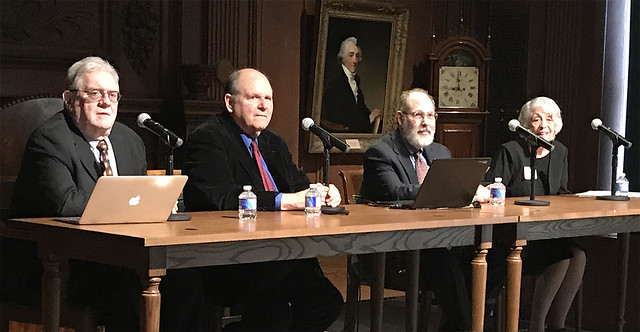
Panelists Robert Hoge, Ira Rezak, Scott Miller, Cory Gilliland
Panel Discussion: "The Art of the Medal"
Ira Rezak, Robert Hoge, Scott Miller, Cory Gillilland: Four experts discuss the concept of art in relation to the medal, and various medallic styles, from those commissioned to
project power and identity through contemporary medals reflecting an artist's creative impulse, no longer bound by shape or medium.
Early Work of Victor David Brenner
Patrick McMahon on the earliest part of Brenner's career as a "medalleur" in the 1890s.
So Called Dollars
Jonathan Brecher introduces the world of So-Called Dollars, medals roughly the size of a one dollar coin. The term derives from Bryan Money of the 1890s and encompasses a wide
range of subjects to the present day.
Books & Medals
MHS President Catherine Allgor's welcome / Len Augsburger surveys numismatic literature, printed and electronic, in relation to medals.
Medallic Art Company Archives at the ANS
Ute Wartenberg Kagan recounts the American Numismatic Society's efforts to save America's medallic heritage by securing the archives of the Medallic Art Company from the auction
block.
Panel Discussion: "Why Collect Medals?"
Stephen Scher, John Sallay, Robert Rodriguez, Q. David Bowers: Four prominent collectors reflect on their collecting careers and what initially drew them to medals. With an
afterword by John Adams.
The full playlist is at:
https://www.youtube.com/playlist?list=PL1FU5Ln1f9NUiUPLqE9d0iclcC1_dOPnG
These presentations are also available on the MCA website at
https://www.medalcollectors.org/multimedia/video and on the MHS website at
www.masshist.org/video.
All of the presentations were published in full color with commentary in the December, 2018 issue of The MCA Advisory. A few extra copies of this 112 page issue are still available from the MCA for $20 plus postage while supplies last. Contact Bob Williams at tcp573@aol.com.
To read the earlier E-Sylum article, see:
MEDAL COLLECTORS OF AMERICA MEETS IN BOSTON (https://www.coinbooks.org/v21/esylum_v21n45a06.html)

PRINCETON NUMISMATIC DATABASE COORDINATOR
Alan M. Stahl is Curator of Numismatics at Princeton University's Firestone Library. He passed along this job opening. -Editor
Application for Database Coordinator, Framing the Late Antique and early Medieval Economy (FLAME)
 FLAME (Framing the Late Antique and early Medieval Economy, coinage.princeton.edu is a digital numismatics projects that reconstructs the early medieval economy CE
325-725 in Western Eurasia. It supplies hard data about the early medieval economy in the form of data on hundreds of thousands of coins, to contribute to the scholarly
understanding of key historical questions in this period such as the fall of the Roman Empire, the rise of Islam, and the origins of the European economy. FLAME has concluded its
first phase (Minting) and is currently working on gathering and organizing Circulation data across Eurasia (comprising millions of data points). we are inviting applications for
the position of a FLAME Project Database Coordinator at the grade of Associate Professional Specialist for the academic year 2020/1. Essential Qualifications are: a Ph.D. in a
related field, academic background in the humanities, and experience in coding.
FLAME (Framing the Late Antique and early Medieval Economy, coinage.princeton.edu is a digital numismatics projects that reconstructs the early medieval economy CE
325-725 in Western Eurasia. It supplies hard data about the early medieval economy in the form of data on hundreds of thousands of coins, to contribute to the scholarly
understanding of key historical questions in this period such as the fall of the Roman Empire, the rise of Islam, and the origins of the European economy. FLAME has concluded its
first phase (Minting) and is currently working on gathering and organizing Circulation data across Eurasia (comprising millions of data points). we are inviting applications for
the position of a FLAME Project Database Coordinator at the grade of Associate Professional Specialist for the academic year 2020/1. Essential Qualifications are: a Ph.D. in a
related field, academic background in the humanities, and experience in coding.
The complete position posting and application can be found at https://puwebp.princeton.edu/AcadHire/apply/application.xhtml?listingId=13962. More information is available from Alan Stahl, astahl@princeton.edu.
MORE ON COIN REPLICAS MADE IN CHINA

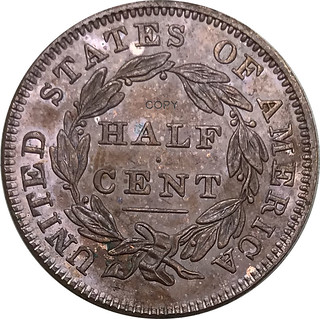
Kavan Ratnatunga writes:
Your report on the 1833 cent reminded me to write to you about AliExpress. The replica copper coins are difficult to detect. They are now stamping COPY but they didn't use to do that. I ordered one about a year ago and it came without any COPY stamp. They still probably also produce on special order without the COPY stamp.
I recently purchased "2019 USA One Dollar Lady Liberty Replica 1OZ Fine Silver Challenge Commemorative Coin" with postage and plastic capsule for US$2. It's silver-plated Iron and attracted by a magnet. No COPY Stamp.
If China can produce this Proof quality at this low price, anything is possible.
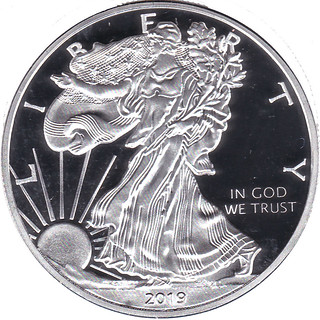
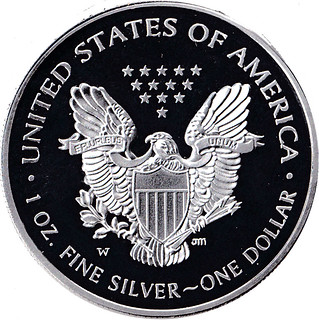
Thanks for the photo. This work is scary good. It's tough to fool real numismatic pros, but these copies are getting good enough to fool a lot of collectors. -Editor
To visit the AliExpress site, see:
United States Of America 1833 1/2 Half Cent Classic Head 99% Red Copper Copy Coins
(https://www.aliexpress.com/item/4000044356364.html)
2019 USA One Dollar Lady Liberty Replica 1OZ Fine Silver Challenge Commemorative Coin
(https://www.aliexpress.com/item/32992123300.html)
To read the earlier E-Sylum article, see:
A FAMILY OF STRUCK FAKE LARGE CENTS (https://www.coinbooks.org/v22/esylum_v22n40a28.html)

NOTES FROM E-SYLUM READERS: OCTOBER 13, 2019
Reaching the 6,000 Subscriber Mark
Yossi Dotan writes:
Congratulations upon reaching the 6,000-subscriber milestone! You do a marvelous job and I wish you (and all the readers of The E-Sylum) that you will be able to continue to do so for many years to come!
Andy Newman writes:
Congratulations, Wayne, on E-Sylum's hitting the mark of 6,000 subscribers. A major achievement, and clear recognition of your hard work and consistency over many years. Bravo.
Thanks. It was a long time coming, and we could slip back below that number at this point with normal reader fluctuation. But we're always eager to share our content with additional interested and interesting readers, so please do continue to recommend us to your friends. -Editor
Electrotype of the 1804 Restrike Cent
David Lange of Numismatic Guaranty Corporation (NGC) writes:
Craig Sholley's piece about the electrotype Neo-Eboracenesis, plus Jack Young's look at some counterfeit large cents, prompts me to write about something interesting that came across my desk recently at NGC. It is a copper electrotype of the 1804 restrike cent, in other words, a fake of a fake.
I suppose the restrike cents were popular enough at some point to boost their population with an electrotype, but I haven't found anything about it in cent literature. I wrote to Denis Loring about this coin, and it is new to him, too. We sent it back unholdered as Not Genuine, but I suppose there are large cent collectors who would desire it even uncertified.
To read the earlier E-Sylum articles, see:
QUERY: 1786 NEO-EBORACENESIS ELECTROTYPES (https://www.coinbooks.org/v22/esylum_v22n40a12.html)
A FAMILY OF STRUCK FAKE LARGE CENTS (https://www.coinbooks.org/v22/esylum_v22n40a28.html)
1794 Starred Reverse Cent Finds
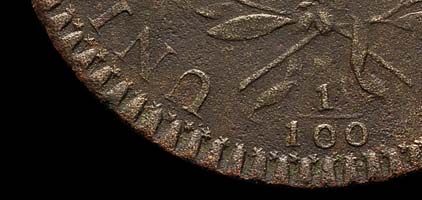
Gene Owen writes:
I saw your 2011 piece about a 1794 Starred Reverse being found.
I found one in a Seattle collection and showed it to Doug Bird and Del Bland. Bland bought it from me at a McDonald's in LA for $3500 in 1988 and I heard he sold it for $8000 a few years later to another collector. It was G-VG based on the Sheldon book and I bought a 1794 book from some guy in Michigan who said mine would be called the 'Owen Discovery‘ !
Wish I had kept it, but needed the money at the time .. wanted to ‘go to Europe on a penny' with new wife- - and did !!!
Cool story. Thanks. I assume the 1794 book was Al Boka's 2005 book Provenance Gallery of the Year 1794, United States Large Cents. -Editor
To read the earlier E-Sylum article, see:
ARTICLE: ANOTHER 1794 STARRED REVERSE LARGE CENT DISCOVERED? (https://www.coinbooks.org/esylum_v14n22a14.html)
Paperboy Pattern Picture Problematic
ANA Edition reader Ken Hill writes:
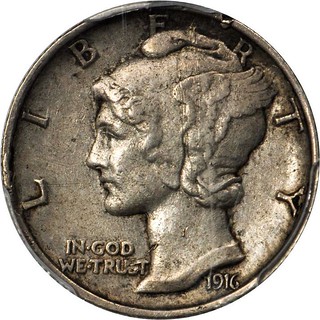 I really enjoy reading The E-Sylum. In the last issue when I was reading about the paperboy who received a 1916 dime from an elderly woman and was using it as a
ball marker. I believe that the dime pictured is a rare pattern and is one of the four types made that year. There were actually six different patterns but the first two had a
motto that was more closely spaced. The dime pictured didn't have the designer's initials and the B is much farther from Liberty's brow. There were some differences on
the reverse which would narrow it down to a specific pattern.
I really enjoy reading The E-Sylum. In the last issue when I was reading about the paperboy who received a 1916 dime from an elderly woman and was using it as a
ball marker. I believe that the dime pictured is a rare pattern and is one of the four types made that year. There were actually six different patterns but the first two had a
motto that was more closely spaced. The dime pictured didn't have the designer's initials and the B is much farther from Liberty's brow. There were some differences on
the reverse which would narrow it down to a specific pattern.
The original article did not include an image and never stated a date for the coin. I just added an image to spice it up since I like to have an image for every article. I was in a rush since that was one of the last stories I added before publishing the issue. I just grabbed a Merc image we already had in our Flickr archive from an earlier article. So it was just happenstance that it was a pattern issue. Sorry for the confusion. I should just pretend that I did it on purpose to see who was really paying attention.
You've got an eagle eye! You're in good company - the only other reader to notice was David Lange of NGC, author of The Complete Guide To Mercury Dimes. -Editor
To read the earlier E-Sylum article, see:
PAPERBOY COLLECTING LESSONS (https://www.coinbooks.org/v22/esylum_v22n40a30.html)
More on the Floating Trophy
Regarding the "Floating Trophy" medal David Pickup asked about, Pete Smith writes:
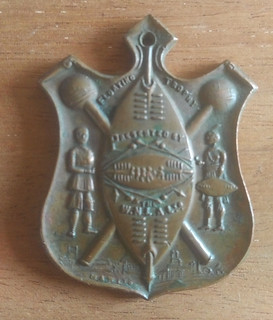 I can't identify the "Floating Trophy" shown in The E-Sylum last week. I believe I can identify some of the elements that make up the design.
I can't identify the "Floating Trophy" shown in The E-Sylum last week. I believe I can identify some of the elements that make up the design.
The shield is a Zulu shield or at least has similarities to a Zulu shield. I first made the mistake of assuming the figure on the right was a native American. However, I now believe this is intended to represent a Zulu warrior.
The staff with a globe on top is a Knobkerrie battle club. Usually this is shown on one side of the shield with a spear on the other side.
The W. NLA Ltd stands for Witwatersrand Native Labor Association Ltd. They recruited native workers to work in the mines of South Africa.
I believe the WNLA Ltd presented a floating trophy for various athletic events. I can't confirm that the medal relates to a specific event.
Dawid Visser writes:
While this is hardly something I specialize in, I believe that the WNLA Ltd in this case refers to the "Witwatersrand Native Labour Association". An employment agency or labour broker for a lack of a more appropriate description that was incorporated around 1901, following the end of the Anglo-Boer war in South Africa.
Their primary function was, as I understand it, to organise and engage unskilled migrant labour primarily amongst the indigenous African population (hence the "Native" part of the name) for the booming gold mines in the region. Although presumably other mining operations would make use of them as well.
The design of the piece also aligns with this as the central shield is evocative of the hide shield used by Zulu warriors and the two implements flanking it appear to be a traditional weapon known as a Knopkierie. The structures in the background to the bottom appear to be a gold mine(although the photo is not very clear).
As this is not actually a token it does not appear to be listed in Hern's guidebook. And as to why this "trophy" was awarded or to whom – your guess is as good as mine. Hope this helps.
Thanks, everyone - this is quite helpful! -Editor
David Pickup writes:
Thanks to Pete and Dawid for this information. Looking at the medal again I think there are mine buildings at the bottom of the design. An interesting piece of history.
To read the earlier E-Sylum article, see:
NOTES FROM E-SYLUM READERS: OCTOBER 6, 2019 : Query: Floating Trophy Medal
(https://www.coinbooks.org/v22/esylum_v22n40a13.html)
Jerry Garcia Check
Phil Iversen writes:
I just reviewed the Sept. 8th issue of The E-Sylum and noticed the royalty check issued to Kurt Cobain. After digging around for a while I finally found a check I have that was issued to rock legend Jerry Garcia of the San Francisco Bay Area band The Grateful Dead. This item and others were featured in an article I wrote and published in the January 2011 issue of The Numismatist. It was issued at the beginning of their career so the amount each band member earned from each event was not all that much.


Thanks! Very cool item. -Editor
To read the earlier E-Sylum article, see:
LOOSE CHANGE: SEPTEMBER 8, 2019 : Kurt Cobain Royalty Check
(https://www.coinbooks.org/v22/esylum_v22n36a31.html)
Zero Cents Political Parody Coin
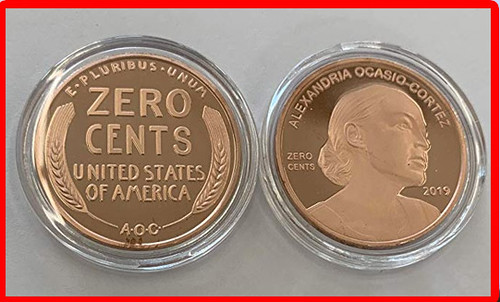
Howard Daniel passed along an article from a parody news site featuring an image of a "Zero Cents" coin modeled after the Wheat Cent reverse. -Editor
To read the complete article, see:
US Treasury honors Ocasio-Cortez with new ‘zero cents' AOC coi
(https://genesiustimes.com/us-treasury-honors-ocasio-cortez-with-new-zero-cents-aoc-coin/)
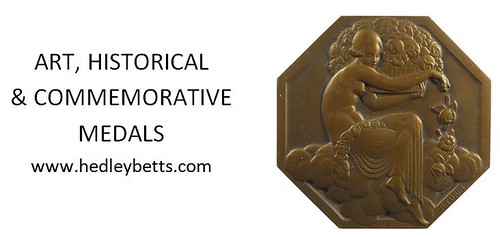
MORE ON THE SHERBROOKE SEMINARY SALE
Warren Baker writes:The material in the Seminaire sale brought very high prices when I was there, which lasted only for the first 52 lots. I later had a bid placed for me, but was unsuccessful.
I did not describe any of the material in the auction. Indeed, I only went to see it a couple of days before the sale. I gave the owner some insights into the collection, which I had long known of. Father Marcotte was one of the enthusiasts at the Sherbrooke Seminary.
There will be three other auctions, the first of which is mainly medals as I understand, which comes up in early November, I believe. The second is a strong collection of Canadian colonial coppers. The third represents The Seminary's collection of foreign coins.
Baker adds:
Here is the biography of Father Leon Marcotte written by Fred Bowman, published in the C.N.R.S. in 1972, as Collectors of Canadian coins of the past.
Fred may have known Marcotte, as he claims the collection to have been his. However, the collection was founded in the early 1890s according to Ron Sigler (writing for the auction firm) by Abbe Charles Jos. Roy, the founder of the Musee de Monnaie at the Seminary of Sherbrooke. Father Marcotte carried it on, after 1905. The Seminary probably counted on donors to acquire the material in their collections.
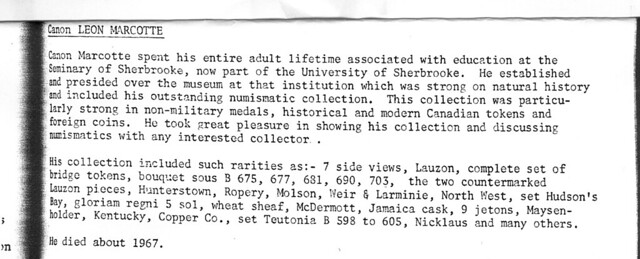
Thanks! We'll look forward to the future sales. -Editor
To read the earlier E-Sylum article, see:
SHERBROOKE SEMINARY SALE SELECTIONS (https://www.coinbooks.org/v22/esylum_v22n39a17.html)
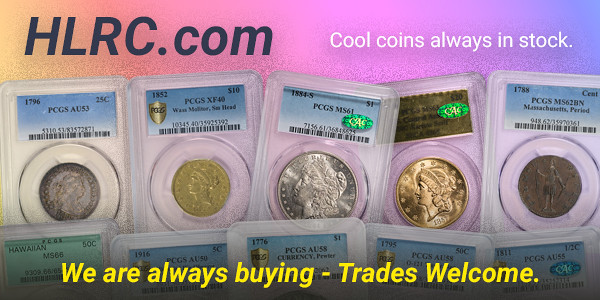
BANKNOTE CATALOG WEB SITE PROPOSED
Aidan Work of Wellington, New Zealand submitted these thoughts on forming a web site for banknotes. -Editor
I have a proposal for a banknote catalog & gallery website that will benefit the numismatic community.
I propose it being along the lines of Numista, which is a coin catalog website at http://en.numista.com.
There are two possible names I think would be suitable for the project - Notista or Nutista.
Either way,what I am proposing is for the website to be built by the numismatic community for the numismatic community.
It will require the assistance of technologically-minded people to actually build the website itself.
After that, it will require the assistance of the major auction houses, numismatic museums, & the major numismatic societies, such as the International Bank Note Society.
Of course, collectors would be invited to have an input by uploading photos of their banknotes, community currency notes, & postal orders, & contributing their knowledge as well.
I am sure Owen Linzmayer would love to see his T.B.B. catalog numbers being used, along with other catalog numbers.
Initially,either Notista or Nutista will be in English,but eventually,it would be a great idea to have Notista or Nutista in other languages as well.
Far too many banknotes remain unlisted in the Standard Catalogs of World Paper Money & in other major catalogs, so I believe very strongly that this needs to be rectified.
Taking a collaborative approach to building a catalog & gallery website for banknotes is the way to go.
What do readers think? The Banknote Book and Standard Catalog are commercial efforts. They require a lot of work and the producers need compensation for their efforts. A crowdsourced effort could do well if there are enough participants but coverage could be spotty - it's hard to be comprehensive and accurate at the same time. But those are no reason not to attempt a collaborative solution.
Aidan can be reached at: britishcommonwealthnumismatics@gmail.com . -Editor
To visit Numista, see:
https://en.numista.com/
VOCABULARY TERM: FINGERPRINT TECHNOLOGY
Dick Johnson submitted this entry from his Encyclopedia of Coin and Medal Terminology. Thanks. -Editor
Fingerprint Technology. Hand work in which cutting, carving, shaping is all accomplished by hand in contrast to mechanical (or computer) controlled manufacture. The handwork can be considered the hand crafting, and the leaving of fingerprints on the item, hence the term. For most of the history of coin and medal manufacture it was accomplished by handworking patterns, dies, tools and presses. Even when the die-engraving pantograph came into widespread use (with mechanically controlled milling of the design) there was still handwork required to put these dies into production.
At the end of the 20th century where laser cutting is in the offering, and computers are programmed to control much of the mechanical work, less fingerprint technology is required. Perhaps in the future such handwork technology will become entirely obsolete.
Computer technology has become far more prevalent in the minting world since Dick penned this entry just a few years ago (although he wasn't using an actual pen - a word processor was involved). Language evolves, but sometimes it doesn't - the same old terms can take on new meanings that encompass newer tools and technologies. -Editor
Looking for the meaning of a numismatic word, or the description of a term? Try the Newman Numismatic Portal's Numismatic Dictionary at: https://nnp.wustl.edu/library/dictionary
Or if you would like a printed copy of the complete Encyclopedia, it is available. There are 1,854 terms, on 678 pages, in The Encyclopedia of Coin and Medal Technology. Even running two a week would require more than 19 years to publish them all. If you would like an advance draft of this vital reference work it may be obtained from the author for your check of $50 sent postpaid. Dick Johnson, 139 Thompson Drive, Torrington, CT 06790.

GEORGE WILLIAM ROBINETTE (1851-1916)
John Lupia submitted the following information from the online draft of his book of numismatic biographies for this week's installment of his series. Thanks! As always, this is an excerpt with the full article and bibliography available online. This week's subject is Virginia dealer George W. Robinette.
The first image is "George and Sidney Robinette with their Exhibition Cabinet of their Indian Relic Collection." -Editor
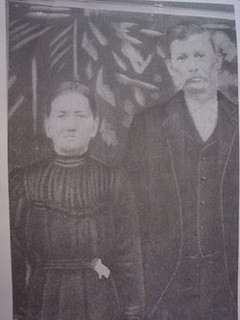 George William Robinette (1851-1916), was born on May 19, 1851, in Russell County, Virginia.
George William Robinette (1851-1916), was born on May 19, 1851, in Russell County, Virginia.
On April 27, 1872, he married Sidney Jane McReynolds (1853-1937). They had twelve children of which three were sons, one died at birth.
Like most American farmers from the beginning of American farming history men enjoyed antiquarian studies and in the process acquired stamps, curios, coins, and other collectibles and George W. Robinette was no different. What makes him stand out in American numismatic history is not his coin collection which was probably a trifle. But, we must be objective and come to the realization that many of these insignificant collections often contained what are todays coveted rare gems selling at auction for small fortunes. What numismatic gems or trite pieces graced the drawers of his cabinet have not been recorded, or at least such record is not known to have survived. What significance G. W. Robinette has in American numismatic history is the jeopardy he placed the Chapman Brothers in, particularly Henry Chapman, Jr., the resident Indian relic expert, who sold many of Robinettes fakes. A nation wide scandal and investigation into the fake Indian relic industry was being systematically exposed in a series of articles in The Archaeologist in 1898. Henry Chapman's name surfaced since so many purchased these from him, he was a national suspect.
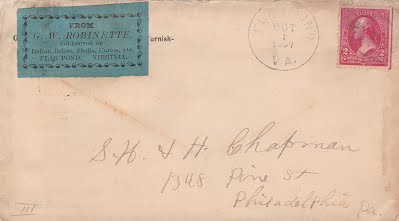
Robinette letter selling and trading his Indian relics to the Chapman Brothers, postmarked October 1, 1897, Flag Pond, Virginia.
The American Archaeologist, ran a very lengthy series of articles on counterfeit American Indian relics in 1898. In the course of publication and replies from readers a very intriguing story began to unfold focusing on different kinds of fake relics but also their geographic regions and names of known sources. Among them were a certain class of Indian relics traceable to G. W. Robinette, Flag Pond, Virginia. He in turn was the supplier to Henry Chapman, Jr., who now needed to be exonerated since Chapman sold a great number of Robinettes fakes to his clients and his innocence needed to be attested to. Fortunately, a Philadelphian aware of the situation who knew Henry and the bad press stories in which he could easily have been caught in the crossfire, came to his rescue with an editorial.
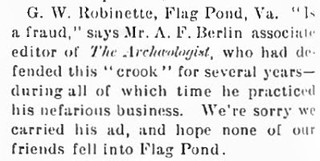 Once these stories ran in the press other editors soon chimed in. The editor of the Virginia Philatelist wrote "G. W. Robinette, Flag Pond, Va. "Is a
fraud," says Mr. A. F. Berlin associate editor of The Archaeologist, who had defended this "crook" for several years--during all of which time he practiced his
nefarious business. We're sorry we carried his ad, and hope none of our friends fell into Flag Pond."
Once these stories ran in the press other editors soon chimed in. The editor of the Virginia Philatelist wrote "G. W. Robinette, Flag Pond, Va. "Is a
fraud," says Mr. A. F. Berlin associate editor of The Archaeologist, who had defended this "crook" for several years--during all of which time he practiced his
nefarious business. We're sorry we carried his ad, and hope none of our friends fell into Flag Pond."
To read the complete article, see:
ROBINETTE, GEORGE WILLIAM
(https://sites.google.com/a/numismaticmall.com/www/numismaticmall-com/robinette-george-william)
The entire inventory of the Lupia Numismatic Library is for sale. Individual items will be available before the remaining archives are broken up into parcels sold at philatelic auctions in the U. S. and Hong Kong. Check NumismaticMall.com frequently as dozens of new items with estimates will be posted daily until everything is sold.
All inquiries will be given prompt and courteous attention. Write to: john@numismaticmall.com .

ANA SERVICE AWARD NOMINATIONS SOUGHT
The ANA is accepting nominations for 2020 service awards. Here's the press release. These are great ways to recognize fellow hobbyists and industry leaders. Please consider making one or more nominations this year. -Editor

Deadline for Award Nominations is Jan. 15
Each year, the American Numismatic Association (ANA) presents awards to deserving individuals in recognition of outstanding dedication to numismatics. The ANA is now accepting individual nominations for 2020 awards and Numismatic Hall of Fame "Historic Era" candidates.
All nominations can be submitted in writing and online – 300 words or more for the Numismatic Hall of Fame, and 50-100 words for all other awards. Nominations are accepted through Jan. 15, 2020.
• Numismatic Hall of Fame – "Historic Era" nominees deceased more than 25 years prior to induction will be considered. Candidates are not required to be past ANA members.
• Farran Zerbe Memorial Award – The ANA's highest honor, this award recognizes years of outstanding, dedicated service to numismatics.
• Lifetime Achievement Award – Presented to an individual, family, firm or judicial entity for contributions to organized numismatics.
• Elvira Clain-Stefanelli Memorial Award for Achievement in Numismatics – This award honors women who have made a lasting impact to numismatic community and demonstrated a lifelong commitment to the betterment of numismatics, whether through research, leadership or mentorship.
• Numismatist of the Year – Recognizes individuals within the numismatic community who have demonstrated long-term leadership in the field and to the ANA.
• Harry J. Forman Dealer of the Year Award – Honors professional numismatists who exhibit uncommon dedication to strengthening the hobby and the ANA and displays exemplary ethical standards as a numismatic dealer.
• Numismatic Art Award for Excellence in Medallic Sculpture – The award honors an artist whose cumulative lifetime achievements in the field of medallic sculpture have been of the highest order.
• Adna G. Wilde Jr. Memorial Award for Exemplary Service – Awarded to an ANA member who has dedicated time and resources to strengthen the hobby and further the ANA's educational mission, setting an example for others to follow.
• Medal of Merit – Recognizes individuals who have dedicated numerous years of service to the ANA and promotion of the hobby.
• Glenn Smedley Memorial Award – This award honors individuals who have devoted their efforts to the betterment of the ANA.
• Lawrence J. Gentile, Sr. Memorial Award for Outstanding Adult Advisor – Recognizes individuals who have devoted their time and efforts to recruiting beginning young numismatists, and aiding the development of intermediate to advanced YNs.
• Young Numismatist of the Year – Honors numismatists under the age of 18 for outstanding contributions to the hobby and who are active in volunteer service and numismatic research.
• Outstanding District Representative – Recognizes the District Representative who most fully promotes coin collecting, coin clubs and the ANA.
Submit a nomination for a numismatist you find deserving of an award. Information about each of the awards and online submission forms can be found here.
For questions about the awards, please contact awards@money.org or call (719) 482-9811.
For more information, see:
ANA Service Awards Categories (https://www.money.org/service-awards-categories)
To submit a nomination, see:
ANA Service Awards (https://www.money.org/american-numismatic-association-awards)

REFORMING THE COMMEMORATIVE COIN PROCESS
Lou Golino published a great article on Coin Update about reforming the U.S. commemorative coin process. Here's an excerpt - be sure to read the complete article online. -Editor
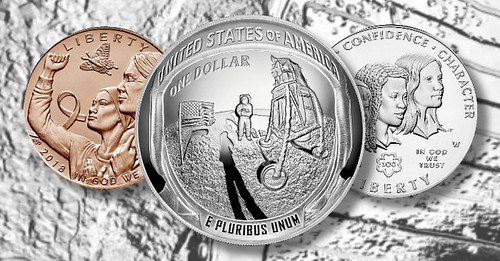
Many collectors of modern U.S. commemorative coins have for years lamented the quality of the designs of many recent issues and questioned the appropriateness of many of the themes commemorated on those coins. That has resulted in a sharply downward trend in sales, with the main exceptions being the two curved coin programs — the 2014 Baseball Hall of Fame and 2019 Apollo 11 50th Anniversary coins, which were both strong sellers. The forthcoming third curved series — the 2020 Naismith Basketball Hall of Fame coins — will likely also do well. The success of these programs was about more than their innovative shape and was also related to the broad appeal of the themes.
Several voices in the numismatic community, such as numismatic researcher Eric Jordan and myself, have for years suggested that if the goal is successful programs that appeal to collectors and non-collectors, greater consideration needs to be given to the types of people, places, and events honored on coinage. Those themes should be broader ones of national importance as opposed to the many narrower ones of recent programs such as those focused on various civic organizations.
The main obstacle to such reforms of the commemorative coin program lies within the United States Congress and, more specifically, in the practice of adding surcharges to the sale of commemorative coins to generate funds for the recipient organizations for these programs. As Eric Jordan has noted:
"Anything you can do to get self-interest for special interest groups out of the equation, the better off we are."
He added that the quality of the designs and appeal of the themes on commemorative coins would benefit from getting rid of surcharges.
There have been growing calls to end this practice, including from some legislators who introduced legislation beginning in 2012 to prohibit the payment of surcharges from the sale of these coins to any entity outside the federal government and redirect any funds in excess of costs to the Treasury to reduce the deficit. But those legislative efforts have repeatedly failed to garner enough support to get very far.
To read the complete article, see:
Reforming the commemorative coin process is an uphill battle
(http://news.coinupdate.com/reforming-the-commemorative-coin-process-is-an-uphill-battle/)

NUMISMAGRAM MEDAL SELECTIONS: OCTOBER 2019
Numismagram's Jeremy Bostwick forwarded along these interesting pieces from the October upload of new material to his website. An eclectic mix, this grouping offers, in addition to the highlights below, multiple medals from pivotal battles during the Crimean War, a couple alluring World War I issues, a few high grade 5 Kopeks of Catharine II 'the Great,' and some pleasing French agricultural plaques. Be sure to check back later this month for a selection of skulls and skeletons in medallic form just in time for Halloween! Visit numismagram.com/inventory for all of these new items. -Editor
Crimean War Bronze Medal
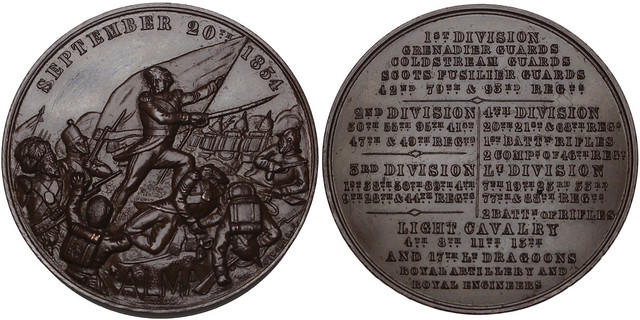
100747 | GREAT BRITAIN & RUSSIA. Crimean War bronze Medal. Issued 1854. The Battle of the Alma (41mm, 40.69 g, 12h). By Messrs Pinches. SEPTEMBER 20, 1854, troops advancing right behind standard bearer; ALMA in incuse below / Legend in 18 lines, listing the participating regiments. Edge: Plain. BHM 2539; Eimer 1490. Gem Mint State. Glossy chocolate brown surfaces, with pleasing luster. Rare in bronze. $385.
Though there were many factors which led to the outbreak of the Crimean War, the main focal point involved Russia's desire for a stronger position around the Black Sea, as this water had long been important in her military strategy and might. The waning of the Ottoman Empire's power provided an opportunity to Russia around not only the Black Sea but also parts of the Balkans. Great Britain and France, neither wanting to see an expanded Russia, banded together to push back the latter. Stalled action in the southeastern Black Sea by the French and British forces caused them to turn their attention to Russia's main naval base on the Crimean peninsula at Sevastopol. This approach led to the successive battles of Alma, Balaclava, and Inkerman, the initial being an allied victory, with the latter two being more indecisive. Nevertheless, the allied presence was felt, and the assault on Sevastopol resulted in her submission, but only after nearly a year. As Russia saw more nations coming to the side of the allies, she had no choice but seek peace and an end to the war in early 1856. One of the resounding effects of their defeat was the decree that the Black Sea be neutral, preventing Russian warships from sailing there and greatly limiting her influence in this vital, warm weather weather port. Almost exactly 160 years later, Russia would again seek to stake her claim in the region, invading and annexing the peninsula away from neighboring Ukraine. This "Crimean Crisis" continues to spark debate and remains very much in dispute. Will a 21st century band of allies repulse this Russian imperialism, similar to that of Great Britain and France of the mid 1850's? Only time will tell.
Heroic battle scene on the obverse, but I'm not a fan of the wordy reverse. Great history. -Editor
To read the complete item description, see:
100747 | GREAT BRITAIN & RUSSIA. Crimean War bronze Medal. (https://www.numismagram.com/product-page/100747)
Edsel B. Ford Silver Award Medal
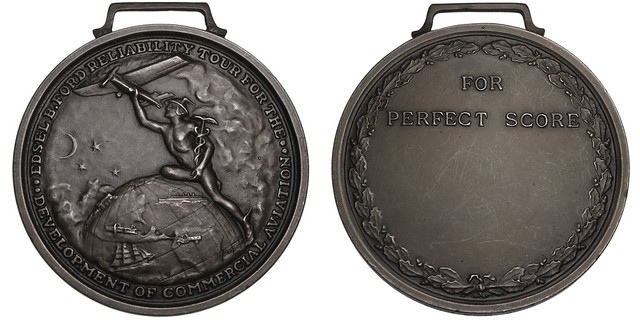
100800 | UNITED STATES. Edsel B. Ford silver Award Medal. Struck circa 1930. Issued for the "Reliability Tour for the Development of Commercial Aviation" (48mm, 60.69 g, 12h). By Gorham Manufacturing Co. • EDSEL B. FORD RELIABILITY TOUR FOR THE • / • DEVELOPMENT OF COMMERCIAL AVIATION •, Mercury flying left, holding model plane and caduceus; below in background, detailed view of the earth, focused upon North and South America, with oversized truck, train, sail boat, and steamship; crescent, stars, and clouds behind / FOR / PERFECT SCORE in two lines; field below left blank for engraving; all within wreath. Edge: GORHAM «3 hallmark» STERLING, clasp attached at top. O'Callaghan, "Ford Motor Company Tokens and Medals of Significant Interest" in TAMS XXXVI.1 (February 1996), p. 14. Choice Mint State. Immensely pleasing steel gray surfaces, with an alluring matte quality and a deeper peripheral tone. Incredibly rare and virtually never seen in the market. $765.
Having been a proponent of advancing the development of commercial aviation for years, Henry Ford created the Edsel B. Ford Reliability Tour, whereby airplane manufacturers had the chance to compete in various events across the midwest in 1925. These events, beginning at the Ford Airport in Dearborn, Michigan, were held in 13 cities overall within a seven day period, and were meant to test the quality and craftsmanship of the airplanes as well as recognize the expertise of their pilots. During the tour's first year, a total of 11 of these 'perfect score' medals were awarded. The tour quickly became a popular annual affair, giving spectators the chance to see many large planes at a time when aviation was still very limited. The final year of the tour was 1932, as the depression had caused attention and funds to be diverted to more pressing economic issues. This incredibly rare and attractive medal, for pilots who achieved a "perfect score," is an unawarded type, possibly from the end of the tour when a few were left over. This cataloger could locate only three examples of this type, all from the initial year of the tour and mostly in rough shape; none of them have any market data and are privately held: Charles (Casey) Jones, Lawrence Richardson, and Glen Martin.
Fascinating bit of aviation history. Great detail on the obverse - use the closeup viewer on the Numismagram site to see more. -Editor
To read the complete item description, see:
100800 | UNITED STATES. Edsel B. Ford silver Award Medal. (https://www.numismagram.com/product-page/100800)
Pope Julius III Bronze Medal
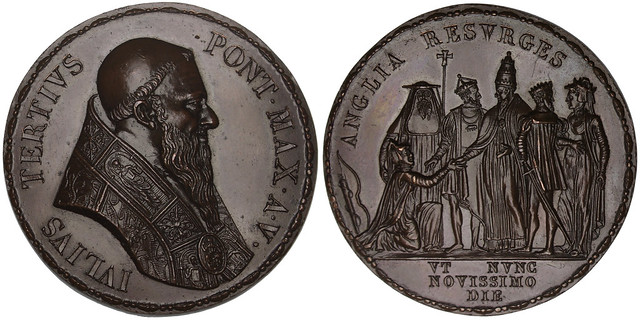
100797 | GREAT BRITAIN. England. Pope Julius III bronze Medal. Dated RY 5 (1554), though a 19th century restrike. Commemorating the brief restitution of Anglo Popery (46mm, 54.00 g, 12h). After G. Cavino. IVLIVS TERTIVS PONT MAX A V, bust right, wearing zucchetto and mantum / ANGLIA RESVRGES (England, though shall rise again...), Pope Julius standing left, raising personification of England kneeling right, casting aside bow and quiver; in background, Cardinal Reginald Pole and Holy Roman Emperor Charles V standing facing; to right, Philip and Mary standing facing one another; in three lines in exergue, VT NVNC / NOVISSIMO / DIE (...as now, at the last day). Edge: Plain. Cf. MI 70/15 (for prototype); Eimer 31c; Mazio –; cf. Lincoln 553-5 (same). Choice Mint State. Deep glossy brown surfaces with a sharp strike and intense luster. A seldom seen restrike of this rare and historically interesting type. $495.
On account of Henry VIII's quarrel with Rome and Pope Clemens VII, Henry was excommunicated and thus, installed himself as the head of the newly established Anglican Church. When Mary (Henry's daughter by his first marriage to Catherine of Aragon) became queen, she wished to restore the religion of her mother and cousin, Holy Roman Emperor Charles VI (Carlos I of Spain), returning the Catholic Church to England. That very act is represented on this restrike medal, with Pope Julius III raising up the kneeling personification of England, while he is surrounded Reginald Pole (the final Catholic Archbishop of Canterbury), Charles V (Holy Roman Emperor and Mary's first cousin), Philip (Mary's husband and first cousin once removed), and Mary herself, clutching her seemingly swollen stomach in the hope of producing an heir. In the end, the pregnancy would be false and Mary would fail to have issue. Meanwhile, her reign–and the restoration of Catholicism to England–would end just a few years later in 1558 with her death at the age of 42 and the accession of her Anglican half-sister, Elizabeth I, who would return the primacy of the Church of England.
So much history, just one medal. I especially like the obverse, with the Pope's intricate vestments. -Editor
To read the complete item description, see:
100797 | GREAT BRITAIN. England. Pope Julius III bronze Medal. (https://www.numismagram.com/product-page/100797)
French World War II Bronze Medal
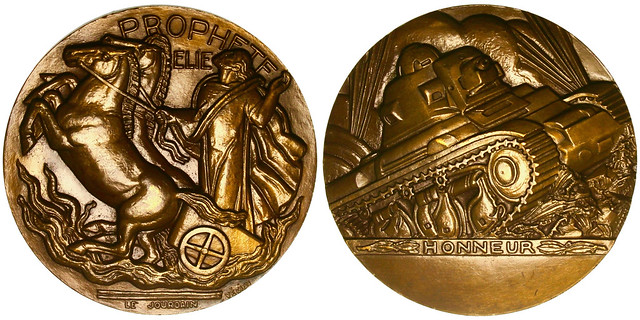
100753 | FRANCE. World War II bronze Medal. Issued circa 1940. The Prophet Elijah/Renault R35 Tank (58mm, 144.24 g, 12h). By E.-J. Vézien in Paris. PROPHETE ÉLIE, the departure of Elijah: the prophet Elijah driving biga of rearing horses, consumed by flames, left unto heaven; LE JOURDAIN in exergue / A Renault R35 tank right, with stylized explosions in background; HONNEUR below. Edge: «cornucopia» BRONZE. Choice Mint State. Pleasing yellow-brown surfaces, with exceptionally high relief. An immensely interesting Biblical/WWII hybrid type. $395.
The exact meaning of these two types is not certain, though the time period during which the medal was made, along with the use of what appears to be a Renault R35 tank, would place it in the early stages of World War II–a time of great concern for Vézien's native France. The prophet Elijah was seen as a miracle worker and a harbinger of the Messiah, and so his depiction could allude to a hopeful France seeking a miracle in the wake of the Nazi onslaught. Meanwhile, the tank depicted on the reverse appears to be a Renault R35, or very similar, which would have seen use around 1940, though its slowness and inability to destroy other tanks made its effectiveness limited. In any event, a highly interesting piece of medallic art depicting a popular wartime implement.
Great stylized piece. -Editor
To read the complete item description, see:
100753 | FRANCE. World War II bronze Medal. (https://www.numismagram.com/product-page/100753)
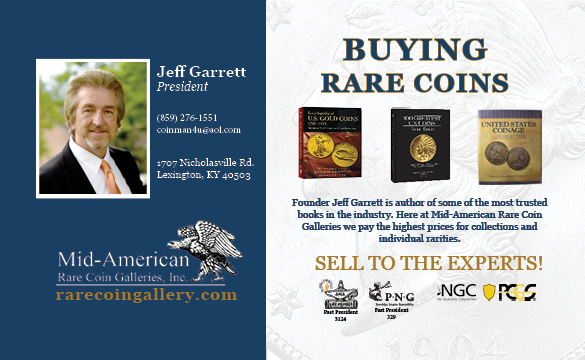
NUMISMATIC NUGGETS: OCTOBER 13, 2019
Here's a selection of interesting or unusual items I came across this week. Tell us what you think of some of these. -Editor
c1849 Washington Birth Centennial Medal
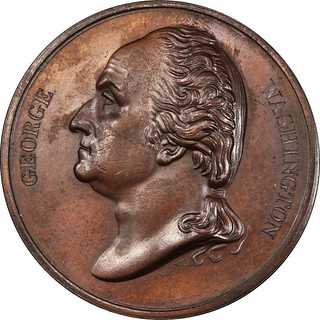

Circa 1849 Birth Centennial medal by C.C. Wright. Second reverse. Wright and Bale mark partly effaced from die. Musante GW-128, Baker-75A. Bronze. MS-63 BN (PCGS).
45.0 mm. 755.6 grains. Deep mahogany bronze with the central reverse field a bit more reddish tan which nicely accentuates the legend. Glossy surfaces with subtle reflectivity in the fields. A trace of very light apparent oxidation is noted on the upper obverse. Double struck on the reverse with more than the usual rotation between strikes evident upon close study. Quite attractive overall, and perhaps just a little nicer than usually seen.
Provenance: Ex William Spohn Baker Collection, to the Historical Society of Pennsylvania by bequest, November 15, 1897.
Nice medal by Charles Cushing Wright from the W. S. Baker collection. In the upcoming Stack's Bowers November 2019 sale. -Editor
To read the complete lot description, see:
Circa 1849 Birth Centennial medal by C.C. Wright. Second reverse. Wright and Bale mark partly effaced from die. Musante GW-128, Baker-75...
(https://auctions.stacksbowers.com/lots/view/3-KF6RF/circa-1849-birth-centennial-medal-by-cc-wright-second-reverse-wright-and-bale-mark-partly-effaced-from-die-musante-gw-128-baker-75)
"CSA Yankee Slayers" Medal
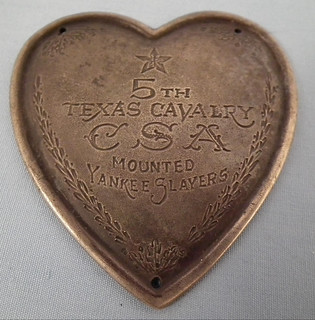
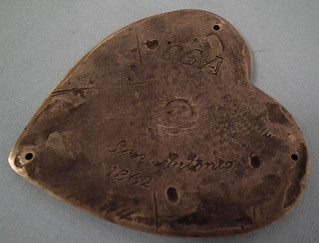
Description: Heart shaped Confederate silver medal - 5th Texas Cavalry CSA Mounted Yankee Slayers, San Antonio Texas 1862. Size: 2.75 in diameter.
This one doesn't pass the smell test. I reached out to E-Sylum reader Alan Weinberg for comment. -Editor
Alan Weinberg writes:
Absolutely a fantasy.
1. Not seen before
2. Legends and design too good to be true
3. Resembles other CSA, Indian wars, famous gunslingers fantasies
4. No evidence of use or pocket carry
Were this genuine it'd be worth $5K++ and I'd pay it
To read the complete lot description, see:
1862 CSA MEDAL (https://www.invaluable.com/auction-lot/-1-c-B7545BA8CD)
1884 Catalogue of the Medals of Scotland
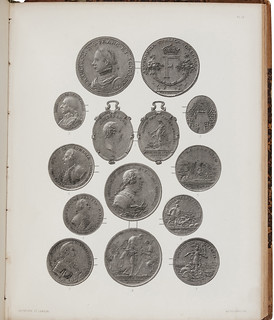 COCHRAN-PATRICK, Robert William (1842-1897). Catalogue of the Medals of Scotland. Edinburgh: David Douglas, 1884.
COCHRAN-PATRICK, Robert William (1842-1897). Catalogue of the Medals of Scotland. Edinburgh: David Douglas, 1884.
4to. 36 autogravure plates. (Some scant spotting.) Contemporary half morocco, marbled boards, top edge gilt, others uncut (some wear, hinges starting). Provenance: Robert Mure McKerrell (Hillhouse armorial bookplate).
LIMITED EDITION, number 32 of 350 copies, of Cochran's record of the coronation of King George V and Queen Mary.
From the Hindman site, owned by Sotheby's -Editor
To read the complete lot description, see:
COCHRAN-PATRICK,
Robert William (1842-1897). Catalogue of the Medals of Scotland
(https://hindmanauctions.com/items/10438987-cochran-patrick-robert-william-1842-1897-catalogue-of-the-medals-of-scotland-edinburgh-david-douglas-1884)
c1889 Hood's Sarsaparilla Advertising Piece
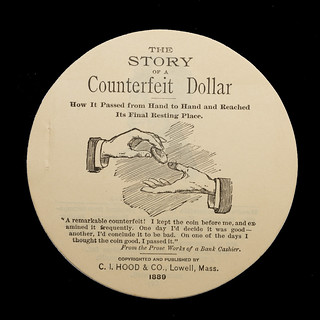
Advertising piece for Hood's Sarsaparilla, featuring The Story of a Counterfeit Dollar, with covers bearing the obverse and reverse of an 1889 Morgan dollar.
I came across this neat item on the Newman Numismatic Portal, in the photo gallery of the Eclectic Numismatic Treasure collection (Miscellaneous section). A search on the web and WorldCat comes up empty for "Prose Works of a Bank Cashier"; is that a book? -Editor
To read the complete image description, see:
Hood's Advertisment (https://nnp.wustl.edu/library/imagedetail/603158)
To view the complete Eclectic Numismatic Treasure photo gallery, see:
Eclectic Numismatic Treasure (Miscellaneous) (https://nnp.wustl.edu/Library/ImageCollection/511837)
1942 Jersey German Occupation Note
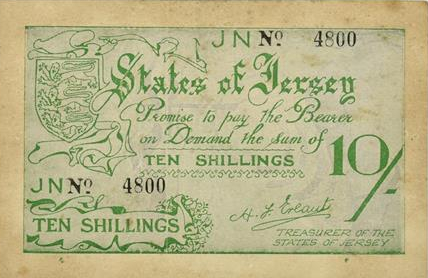
BRITISH BANKNOTE - STATES OF JERSEY - German Occupation
Jersey Occupation Ten Shillings (JN247), serial number 4800, issued April and June, 1942, treasurer H.F. Ereaut, good, slightly stained and discoloured.
Fascinating WWII history. -Editor
To read the complete lot description, see:
Full Details for Lot 717
(http://www.martelmaidesauctions.com/asp/fullCatalogue.asp?salelot=F90014+++717+)
To read a Wikipedia article on the WWII occupation, see:
German occupation of the Channel Islands
(https://en.wikipedia.org/wiki/German_occupation_of_the_Channel_Islands)
1980 Science Nobel Nominating Committee Medal
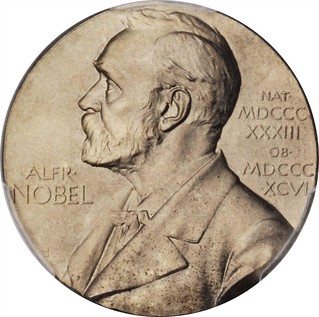
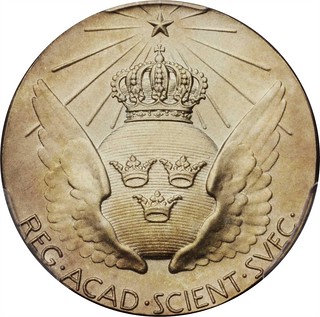
SWEDEN. Nobel Nominating Committee for Science Silver Medal, ND (1980). PCGS SPECIMEN-66 Gold Shield.
Obverse: Bust of Alfred Nobel left; Reverse: Winged and crowned coat-of-arms of Sweden; rayed star above. Edge: F10 (indicating the year 1980). An attractive, satiny piece, featuring argent surfaces and light toning.
I wasn't aware of the existence of these medals until I bought one (for the Medicine Committee) a couple years ago (see my Numismatic Diary article, linked below). Very cool way to obtain an official Nobel medal (without the bother of investing a lifetime in learning, research, and world-changing accomplishment). In the Stack's Bowers October 2019 World Collectors Choice Online Auction. -Editor
To read the complete lot description, see:
SWEDEN. Nobel
Nominating Committee for Science Silver Medal, ND (1980).
(https://auctions.stacksbowers.com/lots/view/3-KDE0E/sweden-nobel-nominating-committee-for-science-silver-medal-nd-1980-pcgs-specimen-66-gold-shield)
To read the earlier E-Sylum article, see:
WAYNE'S NUMISMATIC DIARY: APRIL 16, 2017 : Nobel Prize Committee Silver Medal
(https://www.coinbooks.org/v20/esylum_v20n16a30.html)
THE BOOK BAZARRE
A REINTERPRETATION OF THE 'JUDEA RECEPTA' LEGEND
A Jewish Press discusses historian Linda Zollschan reinterpretation of the 'Judea Recepta' coin legend. -Editor
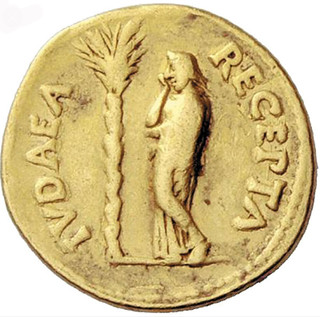 In her current article, Zollschan sets out to argue for a different interpretation of the inscription on the aureus (gold coin equal to 25 silver denarii) of
Vespasian with the legend "Judaea recepta" which on the reverse illustrates Roman formalities for the conclusion of wars.
In her current article, Zollschan sets out to argue for a different interpretation of the inscription on the aureus (gold coin equal to 25 silver denarii) of
Vespasian with the legend "Judaea recepta" which on the reverse illustrates Roman formalities for the conclusion of wars.
"Until now, Judaea recepta was commonly interpreted either as meaning the recovery of Judaea or as an announcement of a return to the embrace of the [Roman] provincial system," writes Zollschan. "However, Judaea recepta indicates surrender, and the aureus with the legend Judaea recepta thus commemorates the Roman acceptance of the unconditional surrender of the Jewish rebels in Jerusalem."
Previous scholars have suggested that the word recepta indicates a message of "recovered" or "recaptured" rather than "captured" and as such, underlines a message saying "rather than conquest by force, a return to the embrace of the provincial system."
The historian then proposes her blockbuster challenge: "whether it is possible to accept that recepta carries that meaning, and therefore whether the aureus conveys the message of a gentler view of Rome's triumph over the rebels in the Jewish revolt.
"The sheer number of coins relating to the end of the first Jewish revolt minted by the Flavians testifies to their use as ‘propaganda on an unprecedented scale' (Ostrowski 1999:154-155).
"While the quantity of coins with the legend Iudaea capta minted in gold, silver and bronze during the reigns of Vespasian and his sons, Titus and Domitian, over a period of 16 years (Brin 1986:10) is vast, only a single find to date has yielded a coin with the legend Iudaea recepta. No other Roman victory produced a similarly large number of coins (TJC:185). They were minted in Rome and across the empire in Lyon, Judaea, Antioch, Tarraco in Spain and Commagene (present-day south-central Turkey). The coins were designed to send a warning made repeatedly to other parts of the empire not to attempt a revolt from Rome (Brin 1986:10). The victory over the Jews was presented as a world event and not as a local uprising, particularly as populations of Jews could be found in many areas of the empire (Overman 2003:216)."
The Roman custom was that surrender was accomplished through a ritual act, Zollschan further explains, with a ceremony that took the form of verbal questions and responses. Only after hearing an affirmative answer did the representative of Rome legally complete the ritual by saying "at ego recipio" (and so I accept [it], meaning the surrender).
To read the complete article, see:
Historian Linda Zollschan
Challenges World Opinion on Roman Coin's "Judaea Recepta" Inscription
(https://www.jewishpress.com/news/history/historian-linda-zollschan-challenges-world-opinion-on-inscription-of-a-roman-coin/2019/10/07/)
Found via The Explorator newsletter. To subscribe to Explorator, send a blank email message to:
Explorator-subscribe@yahoogroups.com -Editor

LINCOLN MEMORIAL CENT VARIETIES
I enjoyed an article published this week by Josh McMorrow-Hernandez on the CDN Publishing site. It's about popular varieties of the Lincoln Memorial Cent. As a collector born the year before the Memorial Cents appeared, I've always been more of a Wheat Cent guy. Those are the coins I pushed into the holes of my blue Whitman folders as a kid. But of course time marches on, and collecting Memorial Cents today can be just as interesting. Here's an excerpt. -Editor
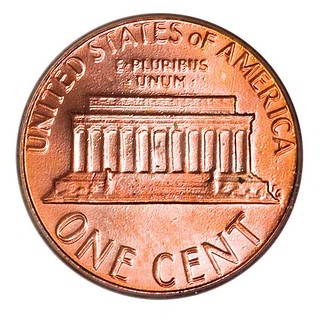 Lincoln cents are arguably the most popular United States series around (shhh… don't tell Morgan dollar enthusiasts I said that). Lincoln pennies are plentiful in change
jars, coin folders, and five-gallon buckets from Bangor, Maine to Los Angeles, California, and beyond, and they're perhaps the most widely collected American coin, even among coin
collectors overseas in foreign lands. Countless collectors love Lincoln cents, and they're often seeking well-known rare wheat pennies such as the 1909-S VDB, 1911-S, 1914-D,
1924-D, and 1931-S. Then there's the famous 1922 "plain" cent, a rare Denver-minted issue that due to some die retooling appears sans "D" mintmark. Finally, we have the 1943
bronze cent, 1944 steel cent, and 1955 doubled die cent—the two former of those being six-figure transitional errors and the last serving as the most famous doubled die variety in
numismatics.
Lincoln cents are arguably the most popular United States series around (shhh… don't tell Morgan dollar enthusiasts I said that). Lincoln pennies are plentiful in change
jars, coin folders, and five-gallon buckets from Bangor, Maine to Los Angeles, California, and beyond, and they're perhaps the most widely collected American coin, even among coin
collectors overseas in foreign lands. Countless collectors love Lincoln cents, and they're often seeking well-known rare wheat pennies such as the 1909-S VDB, 1911-S, 1914-D,
1924-D, and 1931-S. Then there's the famous 1922 "plain" cent, a rare Denver-minted issue that due to some die retooling appears sans "D" mintmark. Finally, we have the 1943
bronze cent, 1944 steel cent, and 1955 doubled die cent—the two former of those being six-figure transitional errors and the last serving as the most famous doubled die variety in
numismatics.
But what about Lincoln Memorial cents? Like their "wheat ears" predecessors, Lincoln Memorial cents are now also an obsolete series, having been first struck 60 years ago in 1959 and retired in 2008. The subtype was replaced in 2010 by the Union Shield type reverse. Dealers have seen an onslaught of pre-1982 bronze cents come in by the bucketful in recent years, as the numismatic community recognizes the potential value these bronze cents have, especially if melting them for their copper content becomes legal again. With current metal prices, bronze Lincoln Memorial cents struck through early 1982 boasts about 2 cents of intrinsic copper value.
But there's so much more to love about Lincoln Memorial cents than their potential bullion payout. While there may not be any major regular-issue rarities among the Lincoln Memorial cent series, there are many varieties that are worth much more than their bronze value—some pieces trade into the hundreds or even thousands of dollars apiece.
Here's my favorite of the group, but see the article for the full list. -Editor
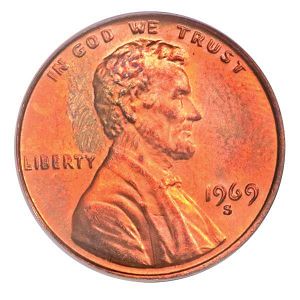 1969-S Doubled Die – Eclipsed by the 1955 doubled die cent in popularity but not in rarity or price, the 1969-S doubled die easily claims the top spot as the most
valuable Lincoln Memorial cent. Fewer than 100 authentic examples are believed to exist (far fewer than the 10,000 to 15,000 surviving 1955 doubled die cents). While extremely
rare, 1969-S doubled die cents have appeared, even in recent years, in the most ordinary of places, including an unemployed woman's 1995 discovery of the coin in pocket change and
the variety's 2007 appearance in an unsearched roll of 1969-S Lincoln cents by collector Michael Tremonti. The rare variety has scored several five- and six-figure auction
appearances in recent years, including the headline-worthy sale of an MS64RD specimen at an April 2018 Stack's Bowers auction in which the coin took a whopping $126,000. However,
among 1969-S doubled die cents, RB specimens are more common; MS63RB specimens are listed in CPG at $60,500 while MS64RBs notch $90,800 apiece.
1969-S Doubled Die – Eclipsed by the 1955 doubled die cent in popularity but not in rarity or price, the 1969-S doubled die easily claims the top spot as the most
valuable Lincoln Memorial cent. Fewer than 100 authentic examples are believed to exist (far fewer than the 10,000 to 15,000 surviving 1955 doubled die cents). While extremely
rare, 1969-S doubled die cents have appeared, even in recent years, in the most ordinary of places, including an unemployed woman's 1995 discovery of the coin in pocket change and
the variety's 2007 appearance in an unsearched roll of 1969-S Lincoln cents by collector Michael Tremonti. The rare variety has scored several five- and six-figure auction
appearances in recent years, including the headline-worthy sale of an MS64RD specimen at an April 2018 Stack's Bowers auction in which the coin took a whopping $126,000. However,
among 1969-S doubled die cents, RB specimens are more common; MS63RB specimens are listed in CPG at $60,500 while MS64RBs notch $90,800 apiece.
You know, for an obsolete series I'm still seeing quite a lot of Memorial Cents in my change. And many of them are bright red, like they're been hidden aware for years and only now coming into circulation. I'm in Northern Virginia. Are people noticing this elsewhere in the country? -Editor
To read the complete article, see:
Did you know about all 13 different Lincoln Memorial cent varieties?
(http://blog.greysheet.com/did-you-know-about-all-13-different-lincoln-memorial-cent-varieties/)
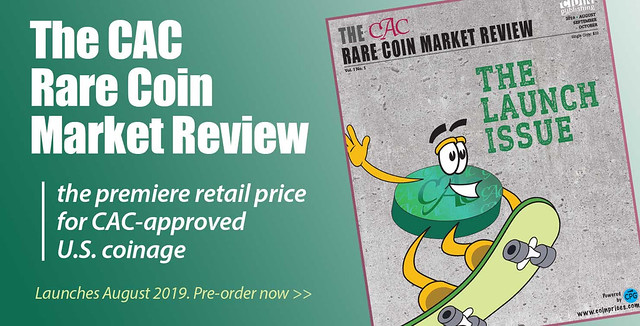
HACIENDA TOKEN OF TEQUILA MAKER GALLARDO
Stack's Bowers cataloger Jeremy Bostwick published a blog article October 10, 2019 on an interesting token in the firm's upcoming online auction. -Editor
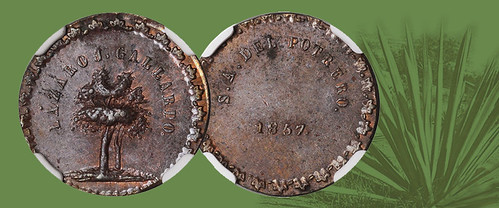
One of the world's more popular distilled spirits was created, somewhat comically, out of shortage of brandy, as explorers in the New World needed a replacement for their alcoholic beverage of choice. Following Spain's conquest and subsequent establishment of colonies in areas such as modern-day Mexico, soldiers and settlers quickly found themselves running short on products they were accustomed to, such as alcohol. Around 1535, with no grapes to be found, the Spaniards focused upon a different source of sugars for fermentation—the agave plant.
The agave had long been used by natives as the base for a milky, alcoholic beverage known as pulque—with an ABV in the 5-7% range—but it was the European travelers who took to distilling the plant. They produced a mezcal that was anywhere between 35-55% ABV, more akin to distilled spirits that would have been available in and around Spain. Over the next three centuries, this beverage would continue to be produced and refined, with subtle nuances applied to its craft. In the 19th century, above ground, steam heated ovens began to be utilized for distillation in some instances, resulting in a beverage that was smoother and sweeter, as opposed to the more savory and smoky notes produced from the traditional clay or copper pots. The former, drawing mostly or only from blue agave, became known as tequila, so named for the town which made it popular. Located west of Guadalajara and in the state of Jalisco, Tequila became an epicenter for the drink, sparking countless producers and methods as the craft was perfected.
One such producer was Lázaro J. Gallardo, who also owned a tavern in Tequila. In 1858, he created a method that he called his selección suave, or smooth selection, whereby newer tequilas were blended with older, smoother, and more refined tequilas, allowing for the highest quality available. This method allowed 'rougher' patches in any particular batch to be rounded out against the rest, creating a smooth, steady baseline that would become immensely popular for Gallardo. So popular was this method that he released the tequila under its own label, styled as Gran Centenario, a brand that is still produced—using Gallardo's method—even to this day.
In this month's Collectors Choice Online (CCO) auction, we have a rather interesting token from Gallardo's hacienda at San Antonio del Potrero in Jalisco. Graded NGC MS-61 Brown, this 1/8 Real token features two trees and Gallardo's name on the obverse, while the reverse bears reference to the hacienda. This splendid piece is dated 1857—one year before Gallardo perfected his selección suave—and is a charming link to an important time in the manufacturing and marketing of one of the world's more popular distilled spirits.
It's not my drink of choice, but fortunes have been made from distilling tequila. Interesting story. -Editor
To read the complete article, see:
A Token of Lázaro Gallardo—Famed Tequila Produce
(https://www.stacksbowers.com/News/Pages/Blogs.aspx?ArticleID=tequila-token-world-cco)
To read the complete lot description, see:
MEXICO. Jalisco. Tequila. Lazaro
J. Gallardo Copper 1/8 Real Token, 1857.
(https://auctions.stacksbowers.com/lots/view/3-KDK1Z/mexico-jalisco-tequila-lazaro-j-gallardo-copper-18-real-token-1857-ngc-ms-61-brown)

RARE SILVER 1921 HARDING INAUGURAL MEDAL OFFERED
James McCartney of Stack's Bowers published a blog article October 10, 2019 about a rare Presidential inaugural medal offered in the firm's upcoming Whitman Coin & Collectibles Winter Expo sale. -Editor
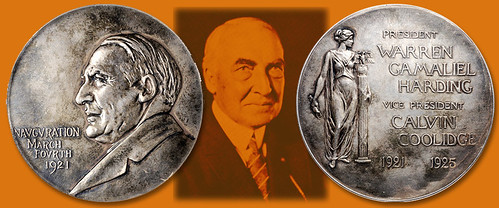
United States Presidential Inaugural medals been official issued since William McKinley's took the oath of office in 1901. For the past 118 years these medals have marked the change of administrations, and can conjure nostalgia or bitterness depending on the events of the four years in-between. Among the rarest issues from this series are those from the 1921 inauguration of Warren G. Harding. Just two were struck in gold and fewer than 10 each are known in silver and bronze. We are thrilled to present an exceptional silver example graded Specimen-63 (PCGS) in our November 2019 Baltimore Auction, where it is being offered as part of the Edmund W. Dreyfuss Collection of Presidential Inaugural Medals.
It is a gorgeous example with glossy surfaces and original patina throughout. The lavender-gray surfaces display colorful iridescence blending golden and violet shades. The strike is very sharp and perfectly centered. File marks at the rim are as-issued and most obvious at the right reverse border. This piece is an exceptional rarity among United States medals and is certainly the holy grail of the Presidential Inaugural series.
The November 1920 victory of Republican Warren G. Harding over Democratic contenders James M. Cox and Franklin Delano Roosevelt was to have been celebrated with "the most dazzling celebration in the memory of the present generation." This event was to be directed by Washington Post publisher Edward "Ned" McLean and his heiress spouse Evalyn. Campaign denunciations of Woodrow Wilson's supposed governmental extravagance, surviving asceticism from the First World War and the sudden lurch of the nation's economy into a vicious post-war Depression derailed the planned extravaganza. Nevertheless, the McCleans offered their own lavish private hospitality, which extended to the striking of this Inaugural Medal in very small quantities by R. Harris & Co. of Washington.
While not as famous as the 1905 Roosevelt inaugural medal by Augustus Saint-Gaudens, the medals of Warren G. Harding's 1921 inauguration are exponentially rarer, and each appearance is a significant numismatic event. Of the fewer than 10 thought to survive in silver, most are held tightly in private collections or institutions. We have not handled a silver example since April 1986 when we sold the collection of David W. Dreyfuss, the present collector's brother. More recently, we offered a bronze example in our March 2011 Baltimore sale which brought $17,250. We expect even stronger interest in this silver piece.
Inaugural medals are a fascinating series to collect, and this is one of the keys. Great medal. -Editor
To read the complete article, see:
Rare 1921 Harding Inaugural Medal in Silver to be Featured in our November
2019 Baltimore Auction (https://www.stacksbowers.com/News/Pages/Blogs.aspx?ArticleID=waren-harding-medal-november-2019)
ROYAL MINT OFFERS GOLD DEBIT CARD
The Bank of England has toyed with the idea of cryptocurrency; now the Royal Mint is stepping into the banking space through partnerships and the retro look of 18K gold. -Editor
 The Royal Mint has produced its first payment card - made of gold and costing nearly £20,000.
The Royal Mint has produced its first payment card - made of gold and costing nearly £20,000.
The 18-carat card can be personalised for customers "who value high-quality luxury items that make a statement".
The Mint has worked with Mastercard and payments technology firm Accomplish to make the debit cards, which cost £18,750 each.
Mastercard say they are part of an account called Raris and will be engraved with the customer's name and signature.
Any other details on the card will cost extra.
Royal Mint chief executive Anne Jessopp said they are "hugely excited" about the launch, which she called an "acknowledgement of growing consumer demands for unique and luxury payments cards".
Ms Jessopp said it represented "a combination of over 1,100 years of Royal Mint craftsmanship with tomorrow's payment technology".
Why fill your wallet with plastic when you can fill it with gold? Buy your burritos in style.
Calculating the true worth and value of such a product is beside the point - the idea is to flaunt wealth for the sake of flaunting wealth. I'm sure some of these will be sold and used. What happens when the account is closed? You wouldn't cut it up and throw it away like an ordinary card. Will these become high-end collectibles? What effect will ordinary wear and tear from usage have? Gold is a soft metal - do these cards have a protective coating to prevent rubbing? And how much gold is in them anyway? The article lists the fineness but not the weight. -Editor
To read the complete article, see:
Royal Mint launches debit card made of gold - but it isn't
cheap (https://news.sky.com/story/royal-mint-launches-debit-card-made-of-gold-but-it-isnt-cheap-11832042)
To read the another article from the altfi site, see:
Royal Mint raises the bar with solid gold payments card
(https://www.altfi.com/article/5832_royal-mint-raises-the-bar-with-solid-gold-payments-card)

SACKLER OXY DOLLAR BLOOD MONEY NOTES
Justin Perrault passed along this article about a recent courthouse protest against the Sackler family and Perdue Pharma, maker of the Oxy Contin drug at the center of the country's opiod crisis. Thanks. The protesters hurled "blood money" notes symbolizing the family's profits from the drug. -Editor

This morning, about a dozen protesters from PAIN Sackler, accompanied by activists from Binghamton-based Truth Pharm, chanted "Shame on Sacklers!"
The activists hurled a blizzard of "blood money" in the air — mock one-dollar bills printed with the word "Oxy" and splattered with red paint — and spilled mock prescription bottles across the steps of the courthouse. They spread themselves across the cement for a 200-second die-in and moment of silence for the nearly 200 individuals who die daily from drug overdoses.
"They have more than enough money to help start treating this crisis," Harry Cullen, an activist with PAIN Sackler, addressed the crowd. "That money belongs to the people who they have killed."

To read the complete article, see:
PAIN Sackler Activists Throw "Blood Money" and Stage Die-in Outside Purdue Pharma's Bankruptcy
Hearing (https://hyperallergic.com/522081/pain-sackler-purdue-bankruptcy-hearing/)
ALTERNATIVE JAPANESE BANKNOTE SHIBA INA DESIGN
A Japanese illustrator has created a fantasy design for a 500-yen banknote. -Editor

In April this year, the Ministry of Finance revealed new designs for the Japanese yen –scheduled to go into circulation in 2024 — featuring an image of Tokyo Station and the Great Wave off Kanagawa, as painted by ukiyo-e wood block master Hokusai.
The redesign prompted Japanese illustrator and manga artist Ponkichi to come up with an alternative banknote of his own, featuring a widely beloved Japanese icon: the Shiba Inu.
Ponkichi's 1,000 yen (US$9.31) note design became so popular it got its own range of merchandise, and now the artist is back with another cute currency, this time with a 500 yen creation.
Japan doesn't actually have a 500-yen note, as the country's banknotes start at 1,000 yen. However, if we were to switch from today's 500-yen coin to a 500-yen note, Ponkichi's design would be hard to beat, with not one, but five Mame Shiba Inu pups gracing its surface.
We recently discussed coloring books with coin designs. Well, this note design has a Memo Notepad, Leather Keyholder, Change Purse and other related merchandise. Why not? It's a cute design. -Editor
To read the complete article, see:
Japanese Mame Shiba Inu banknote design pays homage to
nation's beloved dog (https://soranews24.com/2019/10/09/japanese-mame-shiba-inu-banknote-design-pays-homage-to-nations-beloved-dog/)

GUINNESS RECORD: LARGEST BANKNOTE COLLECTION
I came across this article from a Chinese publication about the Guinness World Record for the largest banknote collection. -Editor
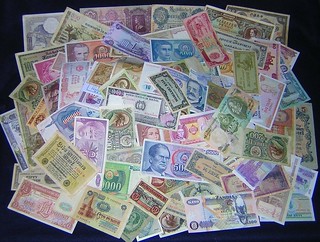 Recently, 42-year-old Wissam Ali Youssef, a Lebanese from Chakra in southern Lebanon, broke a new Guinness World Record for owning the biggest collection of banknotes
with 12,282 pieces from different countries around the world.
Recently, 42-year-old Wissam Ali Youssef, a Lebanese from Chakra in southern Lebanon, broke a new Guinness World Record for owning the biggest collection of banknotes
with 12,282 pieces from different countries around the world.
Youssef expressed his happiness for being able to achieve his dream after long efforts and hard work.
"My first collection of banknotes was destroyed when Israel hit southern Lebanon in July 2006," he said, adding that "the war destroyed my house entirely and all of my collection."
Youssef said that he had started collecting his first banknotes at the age of eight.
"These banknotes were very precious to me. I felt that the war destroyed my passion. These currencies hold a lot of history and culture," he said.
However, Youssef decided not to give up his dream when he watched an exhibition for banknotes on television in 2014.
His passion came back and he decided to start a new collection all over again.
"This was my dream and passion. I thought that I should not allow an act of aggression to destroy my ambition after it had already destroyed my country and house," he said.
Youssef now owns 12,282 pieces of banknotes, breaking the record of an Indian who holds 10,025 pieces.
"Some of my banknotes are gifts from friends who travel regularly to different countries while others were bought from e-bay, merchants and exhibitions," he said.
Youssef's next dream is to establish his own exhibition in his hometown Chakra to showcase all the banknotes that he collected over the years.
Before Youssef's achievement of his goal with his record number of banknotes, the largest collection of banknotes belonged to the Indian Anil Bohora with a total of 10,025 different banknotes, as of Jan. 13, 2009.
Guinness World Record also recognized Leigh Follestad of British Columbia, Canada, for breaking the world record for the largest collection of uncut banknotes.
The article had no images; I added a random picture of banknotes for grins.
I was unable to confirm this claim - the Guinness web site does not list winners, and I don't have a new copy of the book. That's a large collection, but surely someone can come along to top that. I assume duplicates aren't allowed but wonder what the criteria are for the category. -Editor
To read the complete article, see:
Feature: Lebanese man breaks Guinness World Record with biggest banknotes collection
(http://www.xinhuanet.com/english/2019-10/12/c_138467111.htm)
LOOSE CHANGE: OCTOBER 13, 2019
This week we have non-numismatic articles that may appeal to various readers. -Editor
Ancient Roman Visual Aids
Collectors of ancient coins may appreciate this one. -Editor
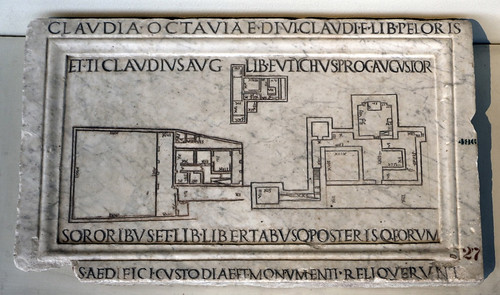
The building plan for a mausoleum
How did regular people within the ancient Mediterranean use visual aids such as lists, calendars, maps, tables, weights and measures, textual illustrations, and even building plans in to organize, access, and then understand the world around them? A new book by classicist and historian Andrew M. Riggsby investigates the types of information technologies (IT) drawn, painted, and inscribed on the surfaces of the ancient Roman world and explores how they shaped the daily life of Romans. As Riggsby demonstrates, effective graphic design has been a tricky but important ability for thousands of years.
To read the complete article, see:
Did the Ancient Romans Use Infographics?
(https://hyperallergic.com/519318/did-the-ancient-romans-use-infographics/)
Bronze Age Gold Jewlery Find
Alan Luedeking forwarded this one about a cool treasure find - a 22-carat gold piece of jewelry dating back to the Bronze Age. Thanks. -Editor
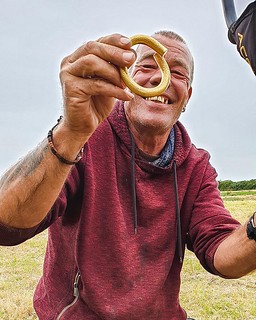 Billy Vaughan, a hobbyist metal detectorist, was out for a walk in his hometown of Whitehaven, England, when he stumbled upon the discovery of a lifetime: a 22-carat
solid gold band dating to the Bronze Age.
Billy Vaughan, a hobbyist metal detectorist, was out for a walk in his hometown of Whitehaven, England, when he stumbled upon the discovery of a lifetime: a 22-carat
solid gold band dating to the Bronze Age.
A care worker by day, Vaughan had taken to strolling around the town in Cumbria, a remote port on England's western coast, with a metal detector. It was a few hours into one recent walk that he got a "strong signal" coming from the earth below, he told the Daily Mail.
When he uncovered the metal about five inches below the ground, it turned out to be a circular piece of jewelry known as a torc. Initially Vaughan thought it was "a piece of climbing equipment, or perhaps coupling from a tractor." In fact, the thick, rod-like object was 11 ounces of solid gold, dappled with small indentations and slightly folding over itself, with one terminal overlapping the other to allow for an opening. Torcs have historically been worn as an indicator of great wealth and social status.
To read the complete article, see:
While Out for a Walk, an Englishman Stumbled Upon a 4,000-Year-Old Solid Gold
Treasure (https://news.artnet.com/art-world/englishman-unearths-4000-year-old-gold-jewelry-1672801)
Everything You Know About the Civil War is Wrong
This one was published in 2017, but I stumbled on it this week. Very interesting look at less obvious but very important economic causes of the U.S. Civil War. Well worth reading. -Editor
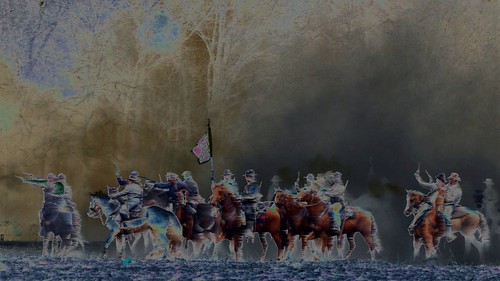
For most of us (including me), we attended public schools where we were provided roughly the same instruction regarding the Civil War: Our country was composed of the North, where people opposed slavery, and the South where slavery was embraced. Abraham Lincoln rose to the presidency and fought against the South to end slavery and saved the Union.
Like most of my high school peers, this story seemed plausible enough to me and after all, it ended happily: Slaves were freed and the Union remained intact.
Plausible enough until I read a couple of books by Charles Adams, a tax historian and author from New England — hardly a Southern extremist with an ax to grind.
In these fascinating books, Adams explores how taxation affected historical events and how the popular interpretation of the Civil War survives in the face of some obvious facts.
I had to revise my thinking.
To read the complete article, see:
Everything You Know About the Civil War is Wrong
(https://medium.com/@jonathanusa/everything-you-know-about-the-civil-war-is-wrong-9e94f0118269)
History of Desktop Publishing
Numismatic authors might appreciate this new history of desktop publishing. -Editor
 History of Desktop Publishing is a personal and encyclopedic story of how the personal computer, unique applications, and many colorful people changed the
creative and print communities. Author Frank Romano has documented the histories of hot metal and phototypesetting and continues the tale of document production in this book. This
installment ends as the Internet becomes a primary focus...
History of Desktop Publishing is a personal and encyclopedic story of how the personal computer, unique applications, and many colorful people changed the
creative and print communities. Author Frank Romano has documented the histories of hot metal and phototypesetting and continues the tale of document production in this book. This
installment ends as the Internet becomes a primary focus...
To read the complete article, see:
HISTORY OF DESKTOP PUBLISHING.
(https://www.oakknoll.com/pages/books/133473/frank-romano-with-miranda-mitrano/history-of-desktop-publishing)
Secret Formula for Eternal Youth
From the Good Clean Funnies list. -Editor
The police recently arrested a man selling "secret formula" tablets he claimed gave eternal youth. When going through their files they noticed it was the fifth time he was caught for committing this same criminal medical fraud.
He had earlier been arrested in 1794, 1856, 1928 and 1983....
To read the complete article, see:
Secret Formula (https://gcfl.net/archive.php?funny=3676)

ROMAN BUTIN'S BEATING HEART COIN
Anne Bentley of the Massachusetts Historical Society passed along a link to this new "Creepily fascinating coin!" from carver Roman Butin. Just in time for Halloween. Thanks! -Editor
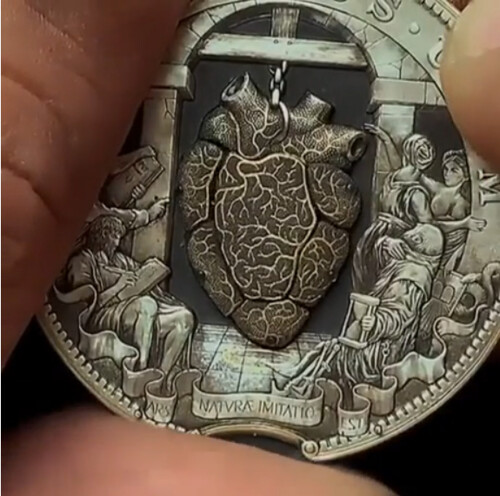
To watch the video (animated .gif), see:
Beating heart coin (https://www.gif-vif.com/Beating-heart-coin)
Here are some behind-the-scenes images from Roman's Facebook page. -Editor
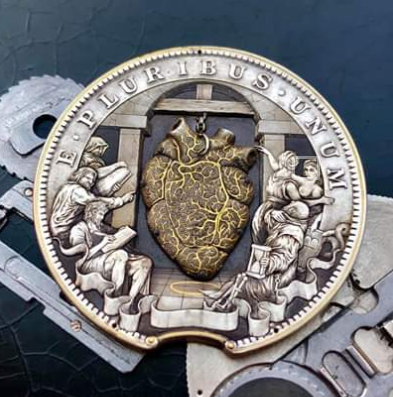

To view Roman Butin's Facebook feed:
Roman Booteen (https://m.facebook.com/roman.booteen)
To read the earlier E-Sylum articles, see:
ROMAN BOOTEEN'S MECHANICAL GOLD BUG COIN (https://www.coinbooks.org/v20/esylum_v20n49a36.html)
ARTICLE PROFILES COIN CARVER ROMAN BUTIN (https://www.coinbooks.org/v21/esylum_v21n28a28.html)
COIN CARVER ROMAN BUTIN'S NEW DESIGN (https://www.coinbooks.org/v21/esylum_v21n42a35.html)
FEATURED WEB PAGE: LIBERTY TRADING COMPANY
This week's Featured Web Page is a collection of mining scrip tokens at the Smithsonian National Museum of American History.Scrip is a substitute for legal tender that was often used in coal towns as a substitute for monetary wages or credit against the miner's next paycheck. Scrip could only be spent in company stores for goods (sold at a a high markup in isolated towns with weak labor unions) and was part of a corporate paternal system of employee benefits that helped management control workers and made labor organization difficult. The Liberty Trading Company of Madera, Pennsylvania issued this scrip for use in their stores. The company produced several different token in $10.00, $5.00, $1.00, .50¢, .25¢, .10¢, and .05¢ denominations.

https://americanhistory.si.edu/collections/search/
object/nmah_1392021

